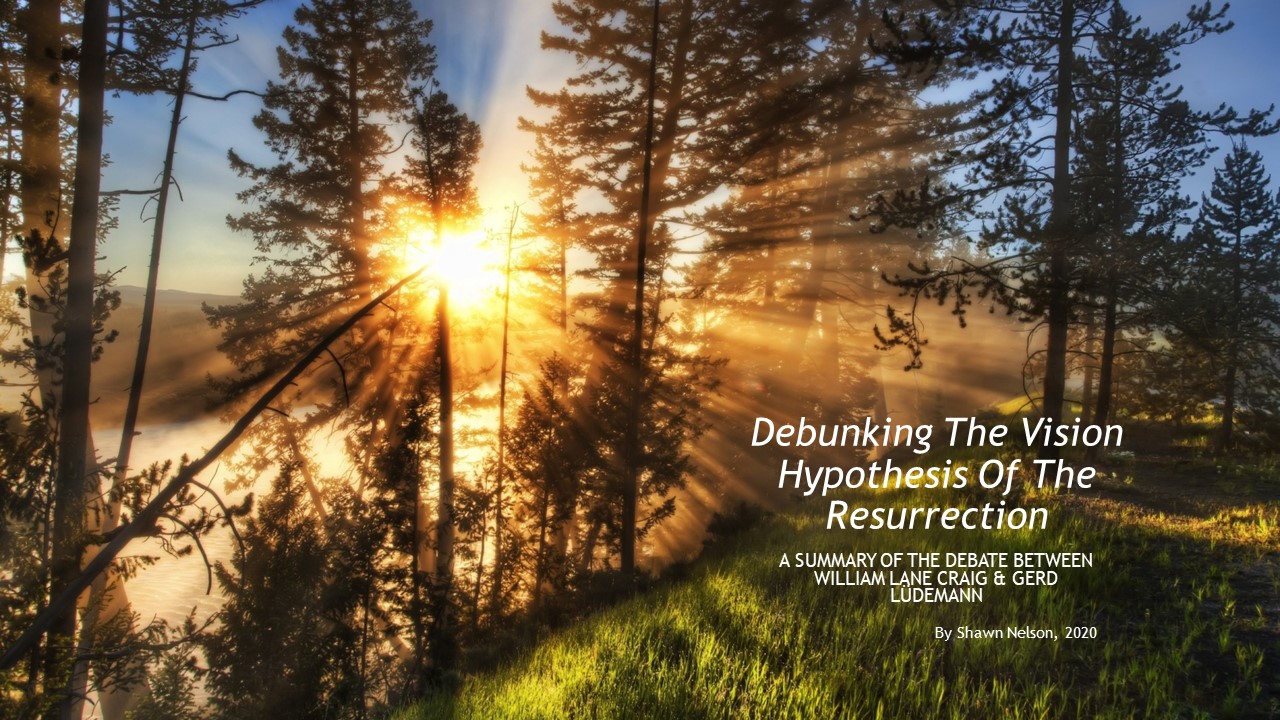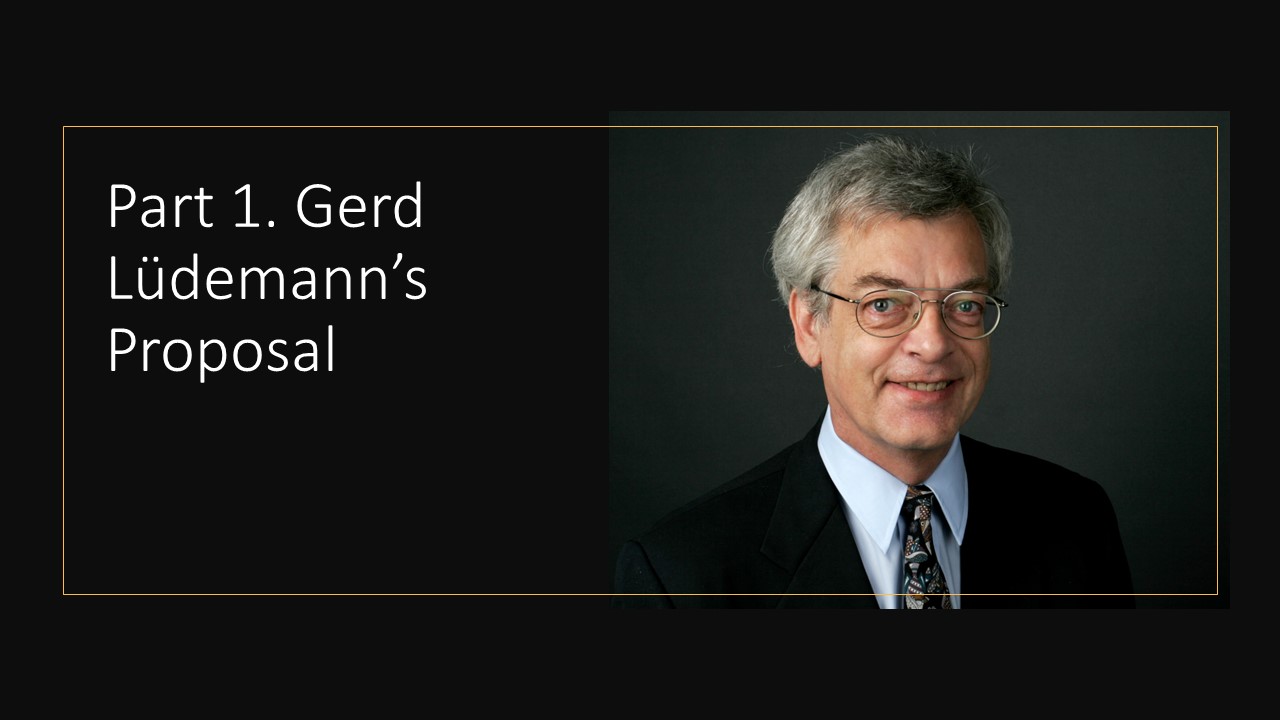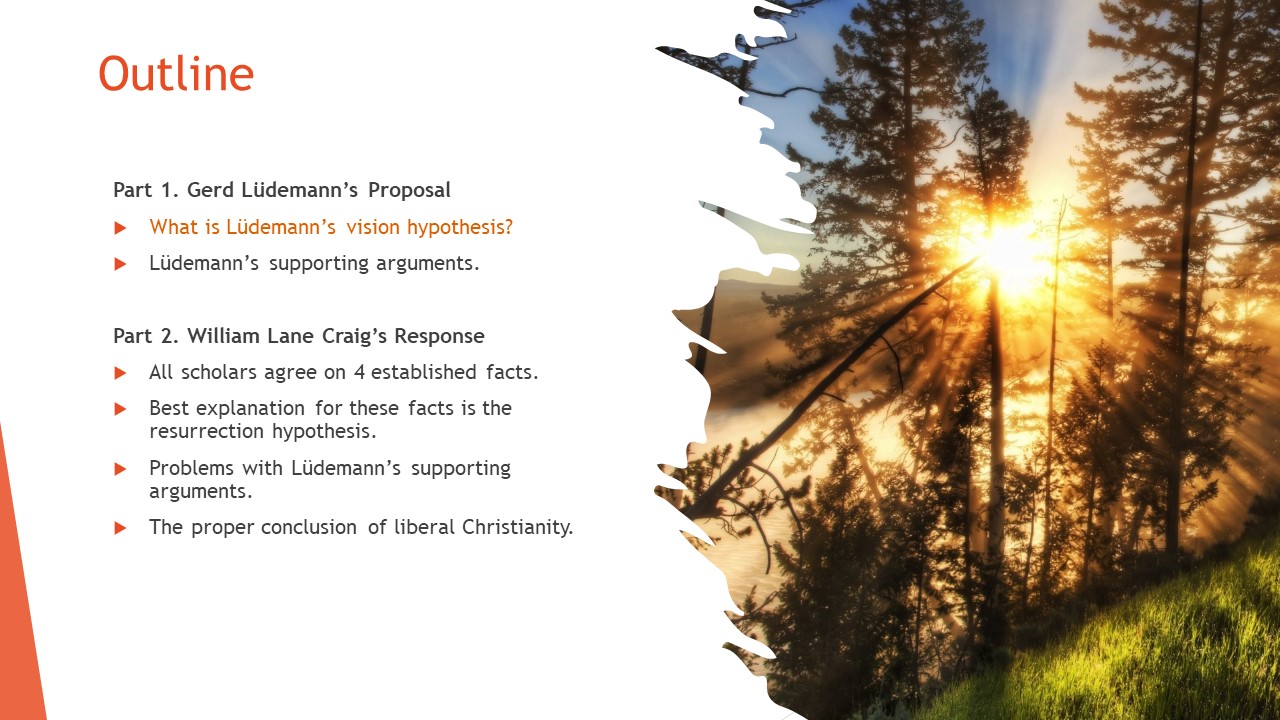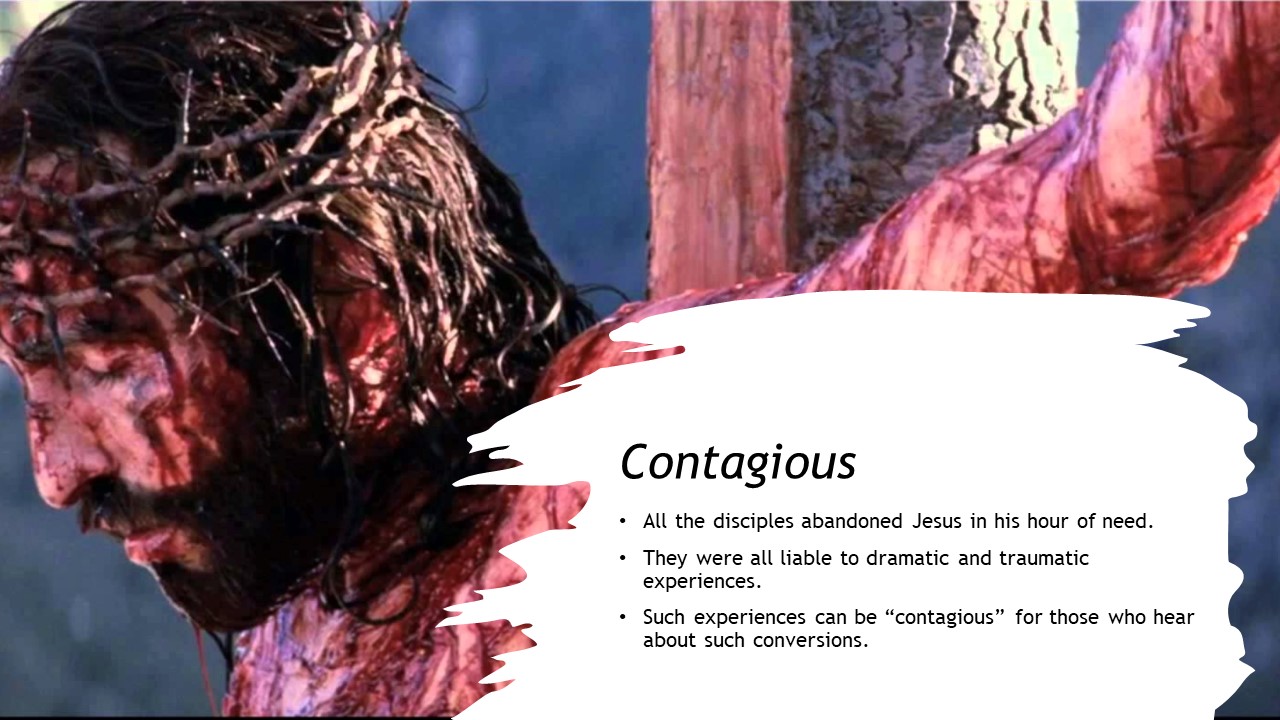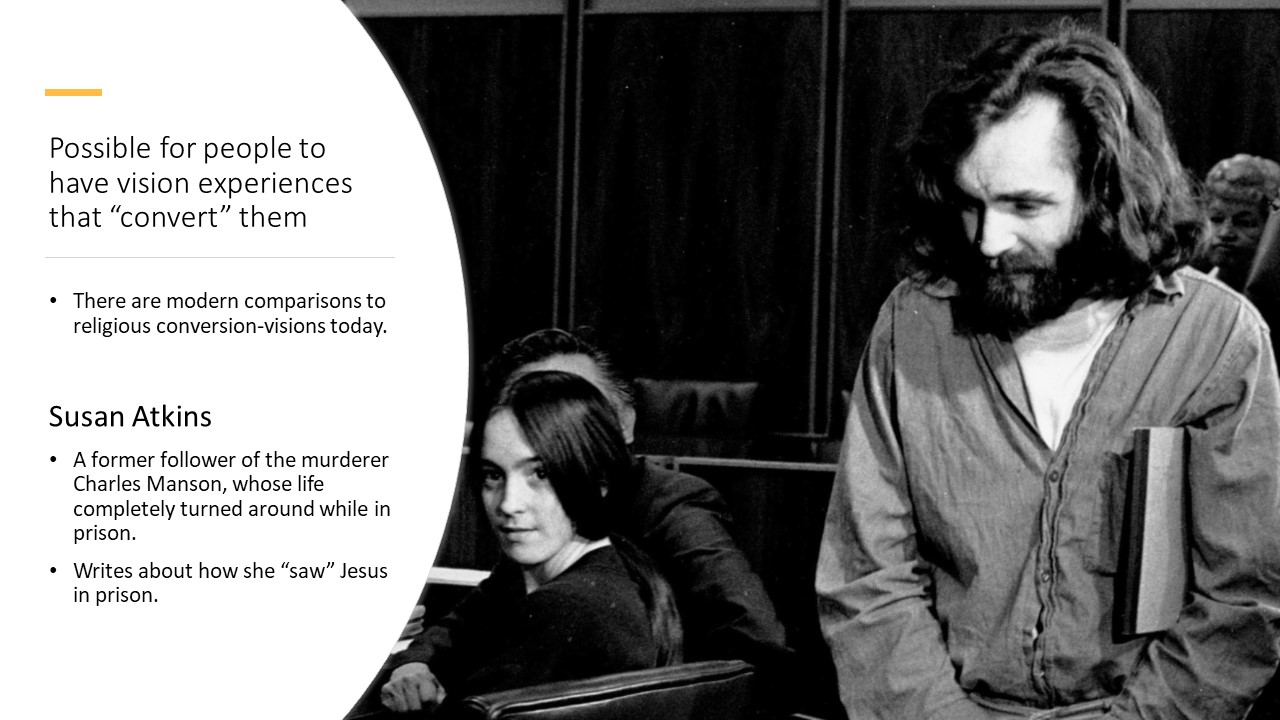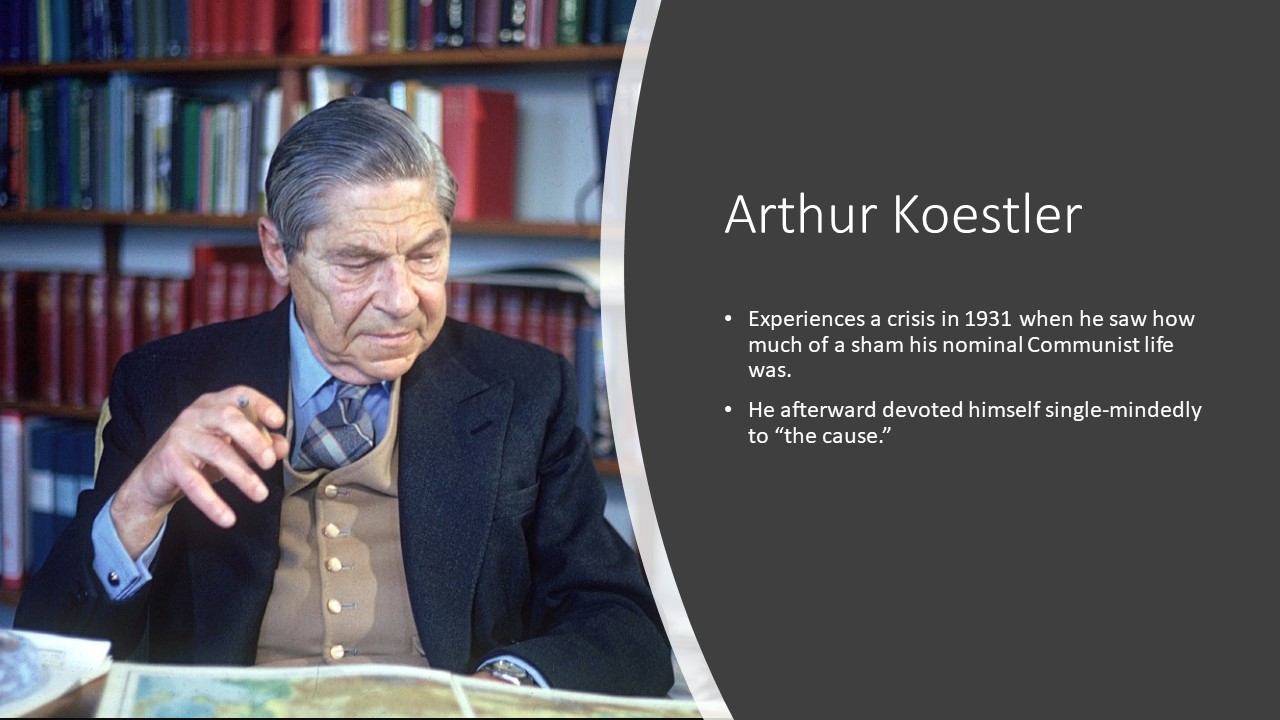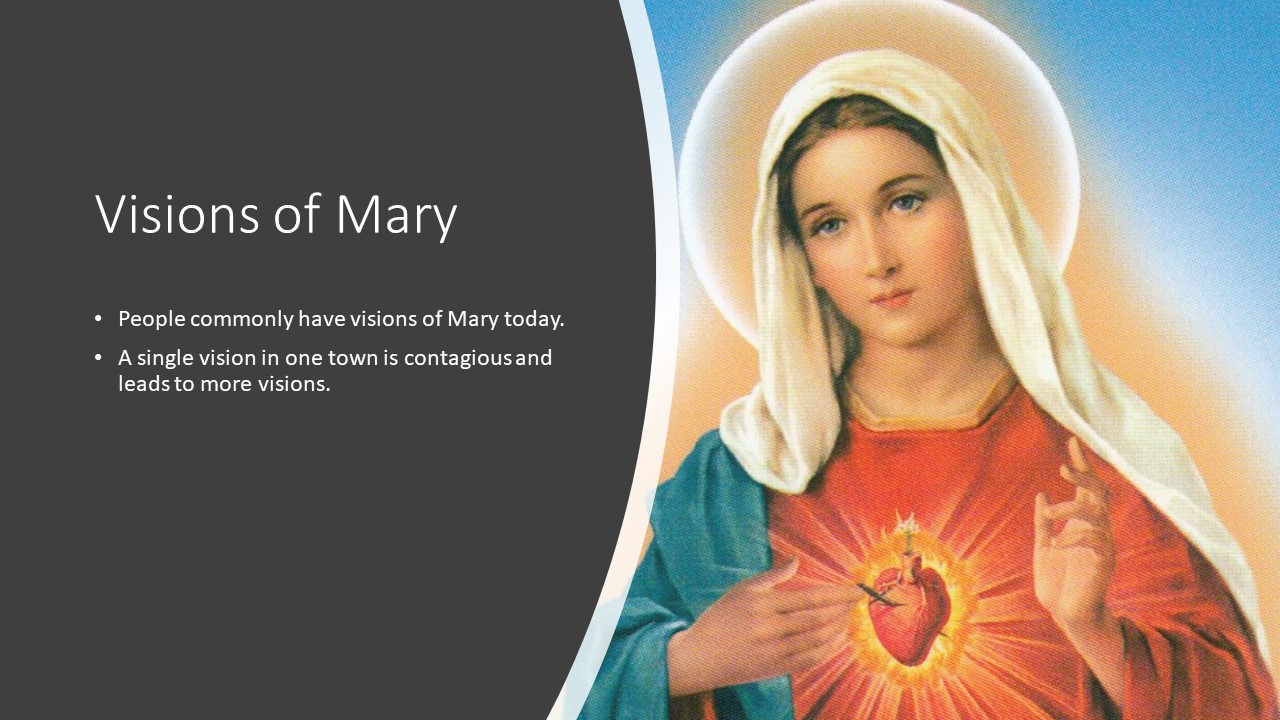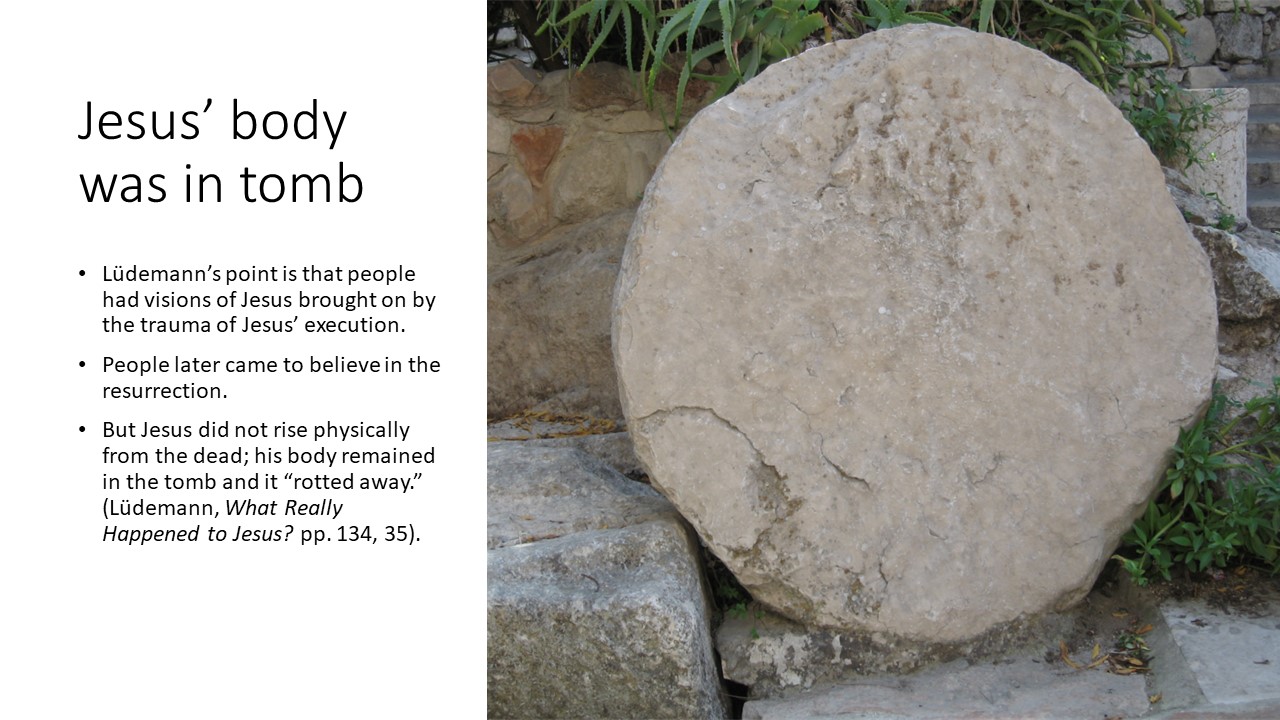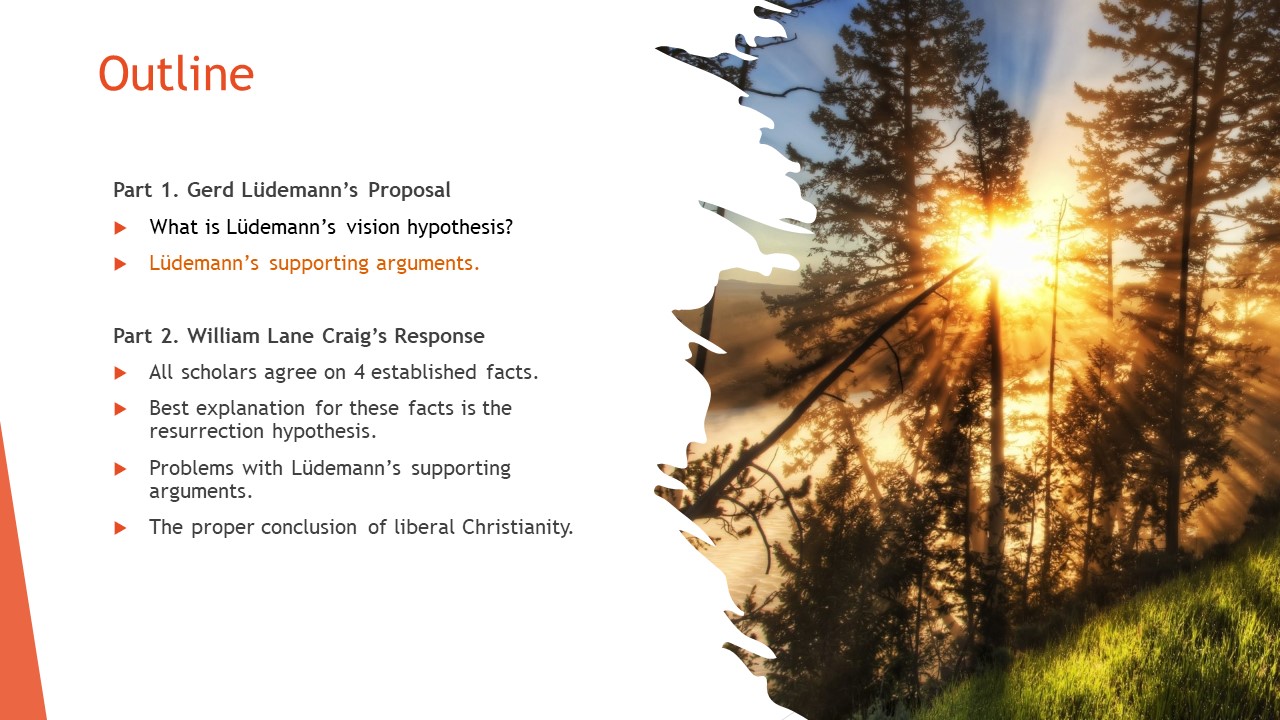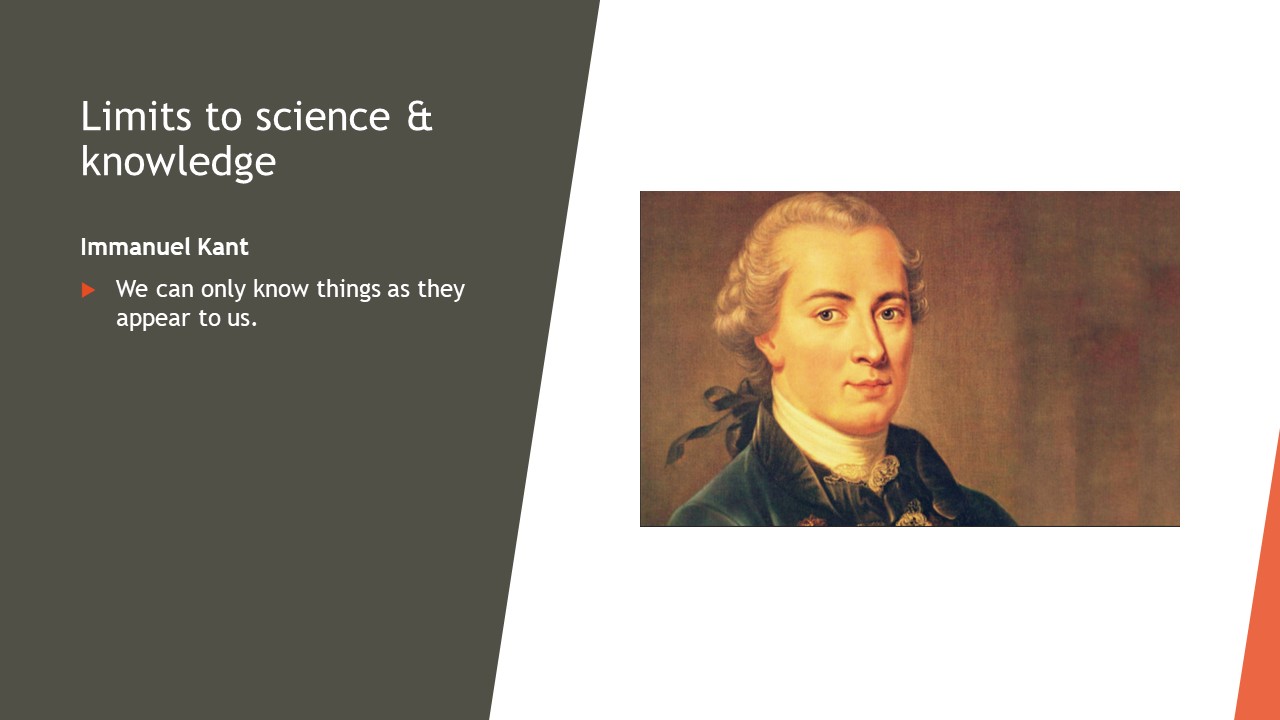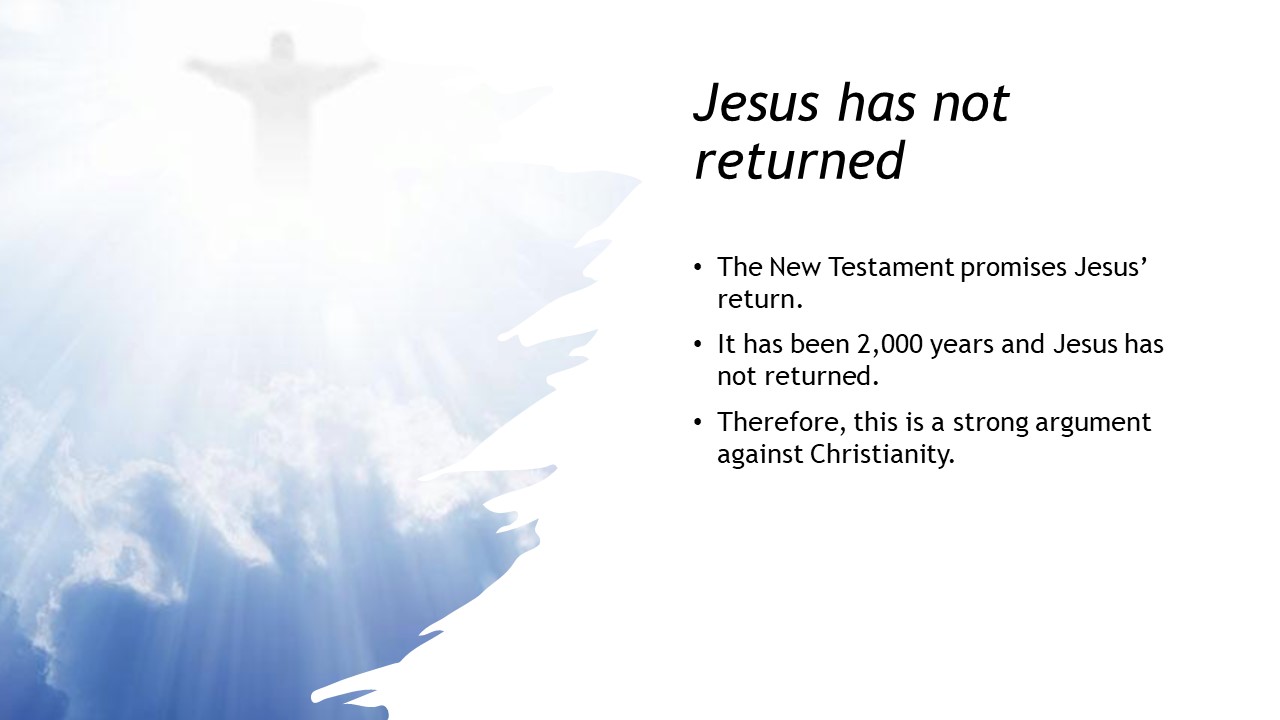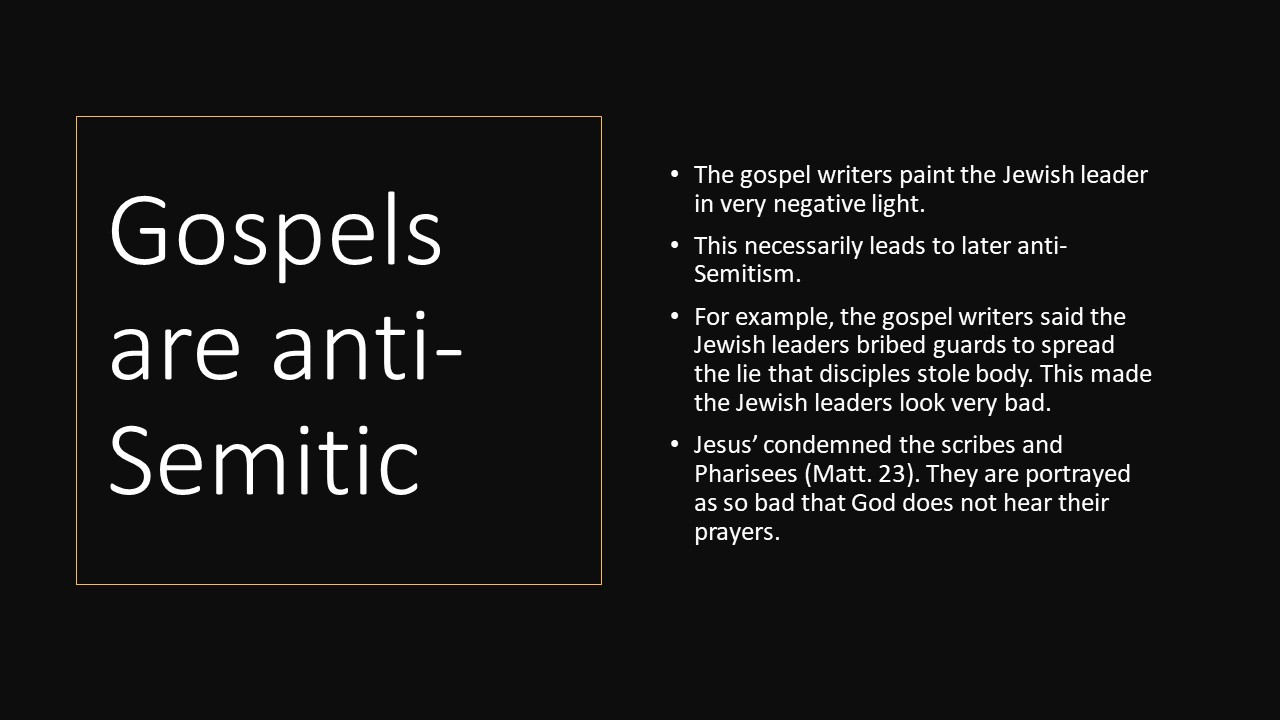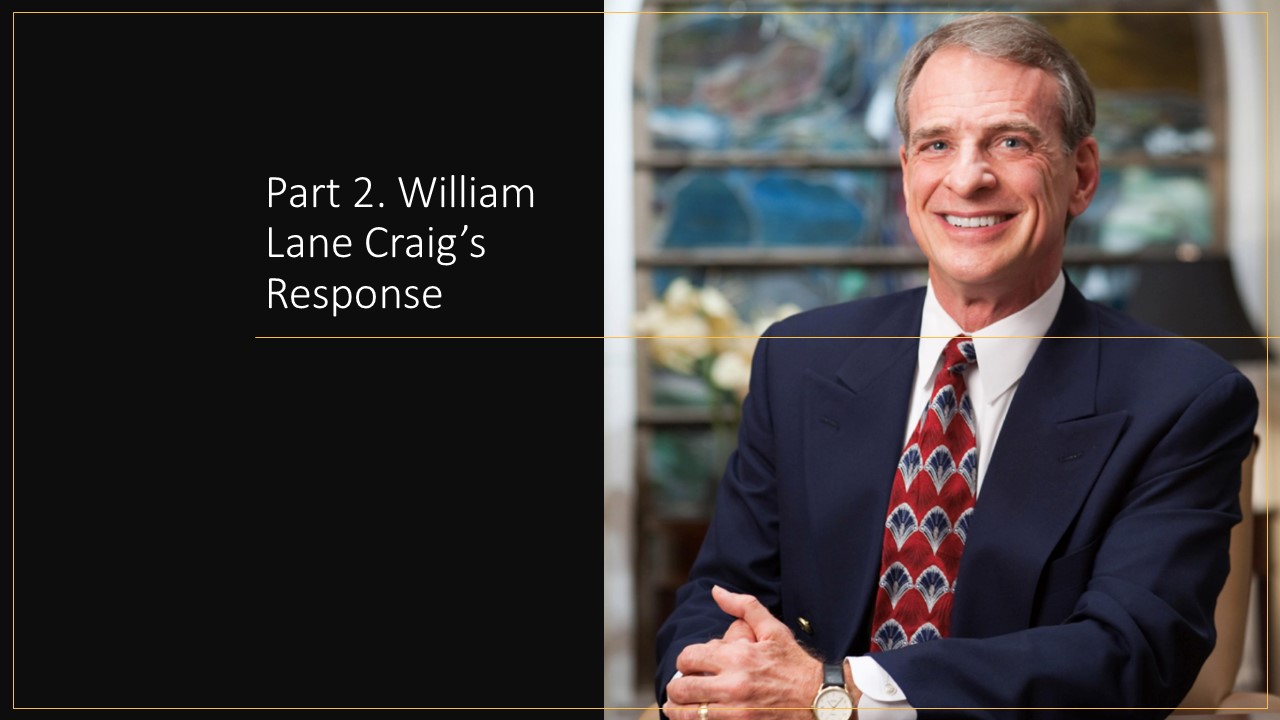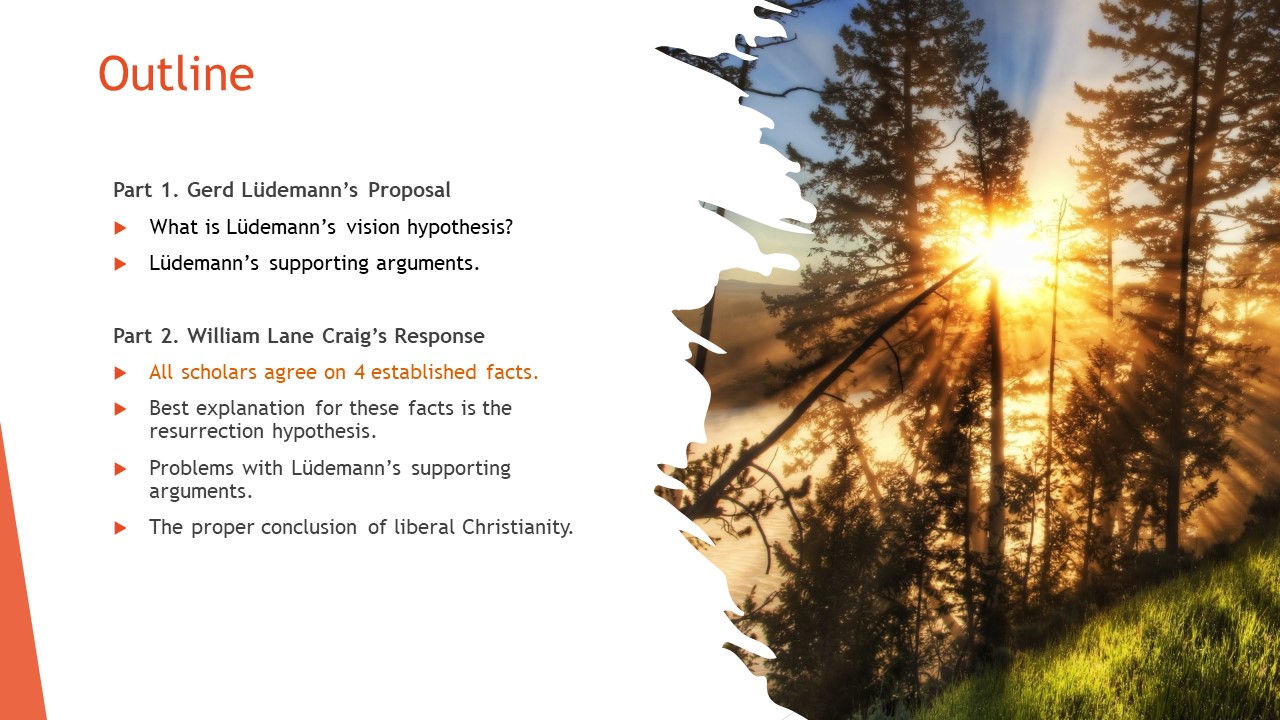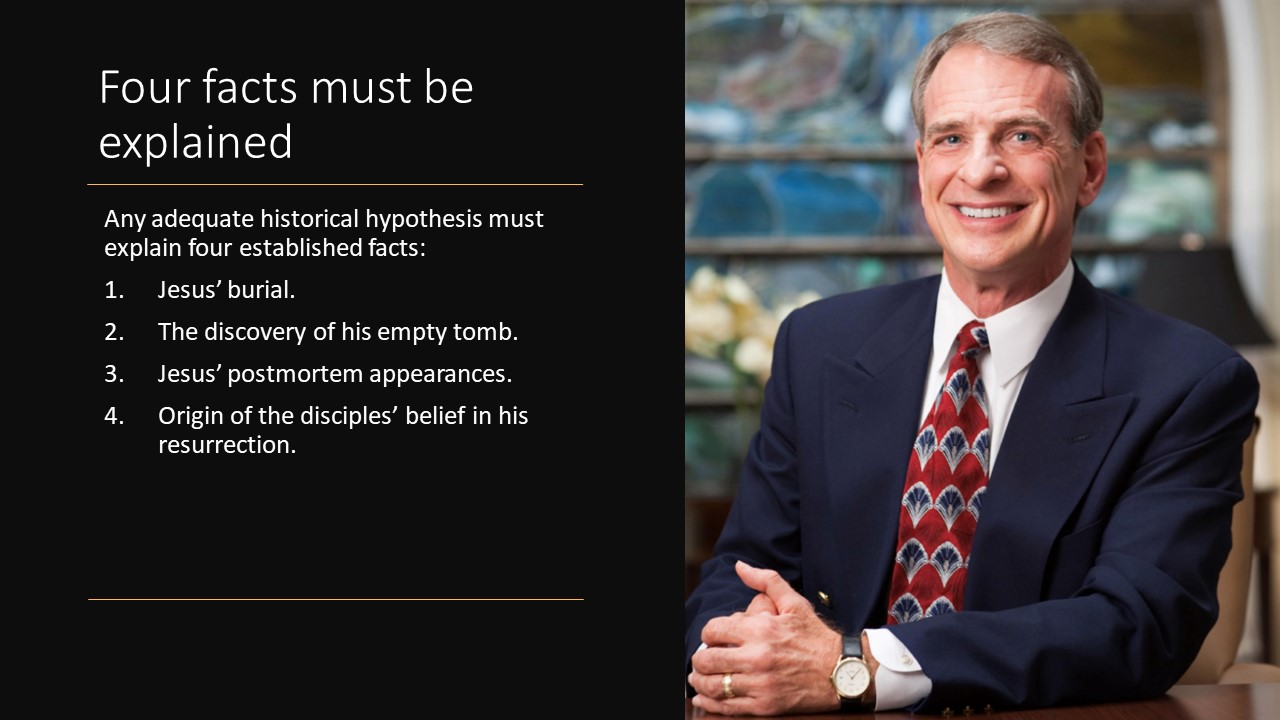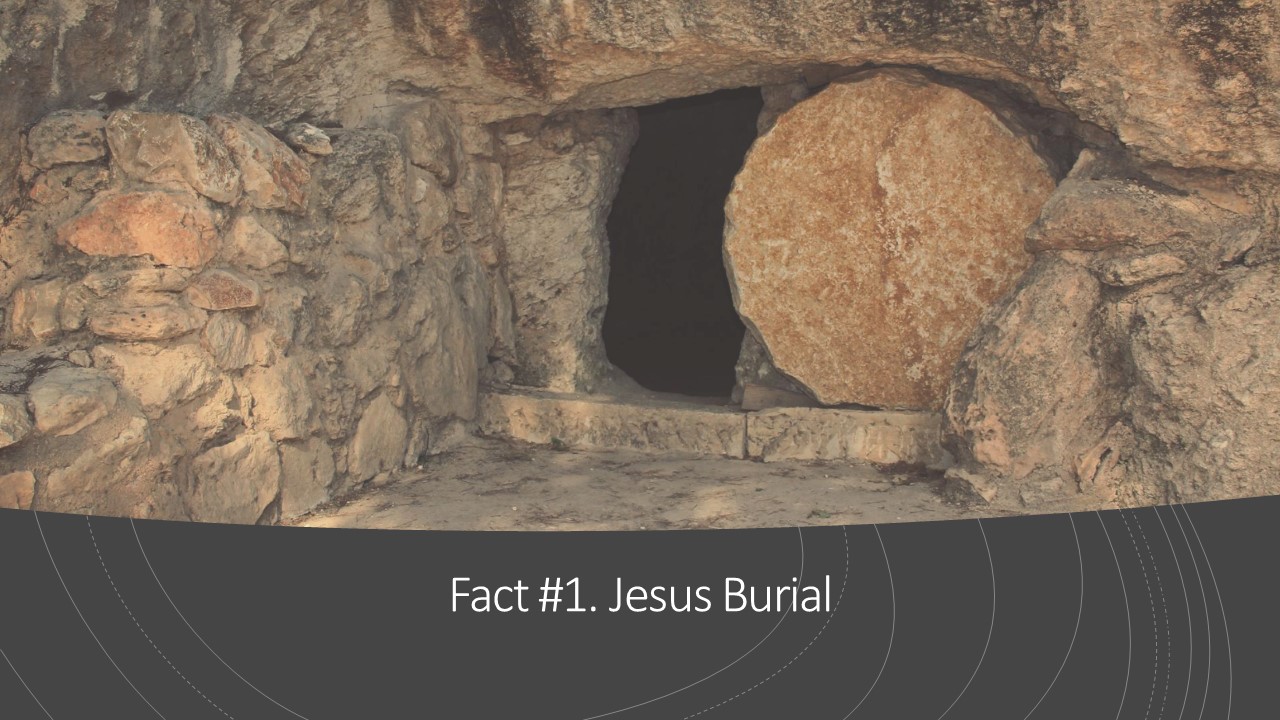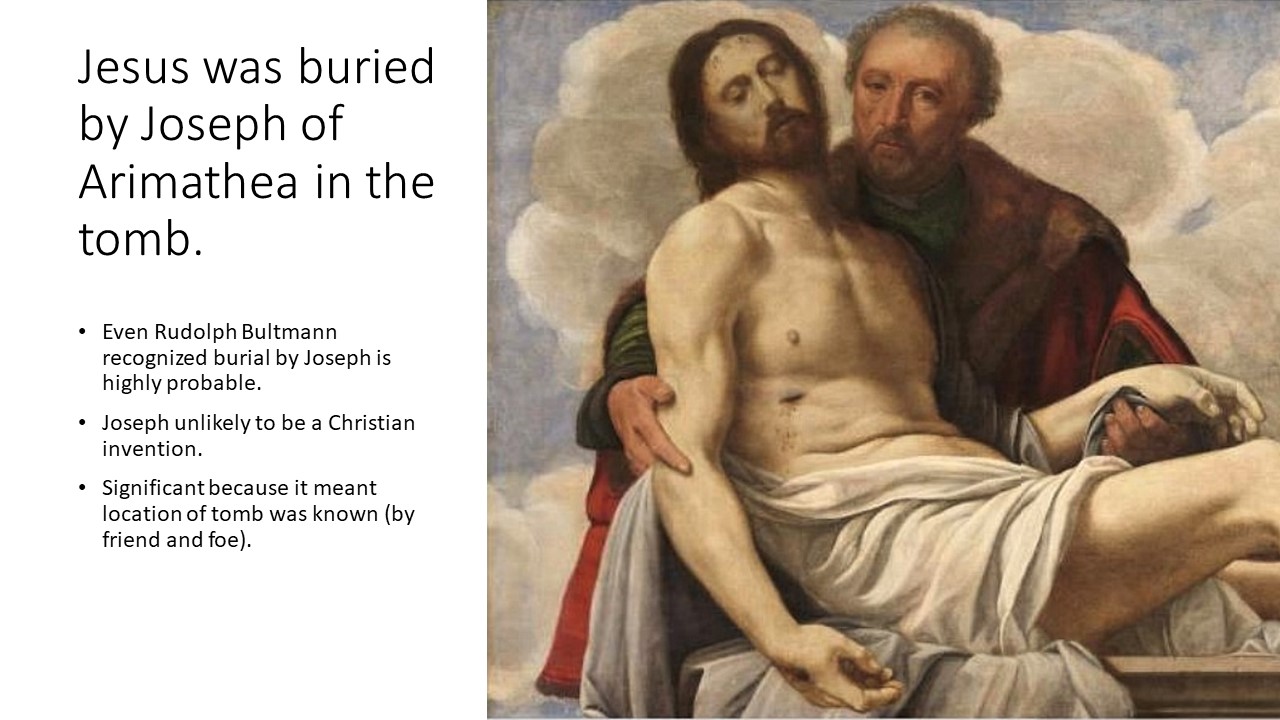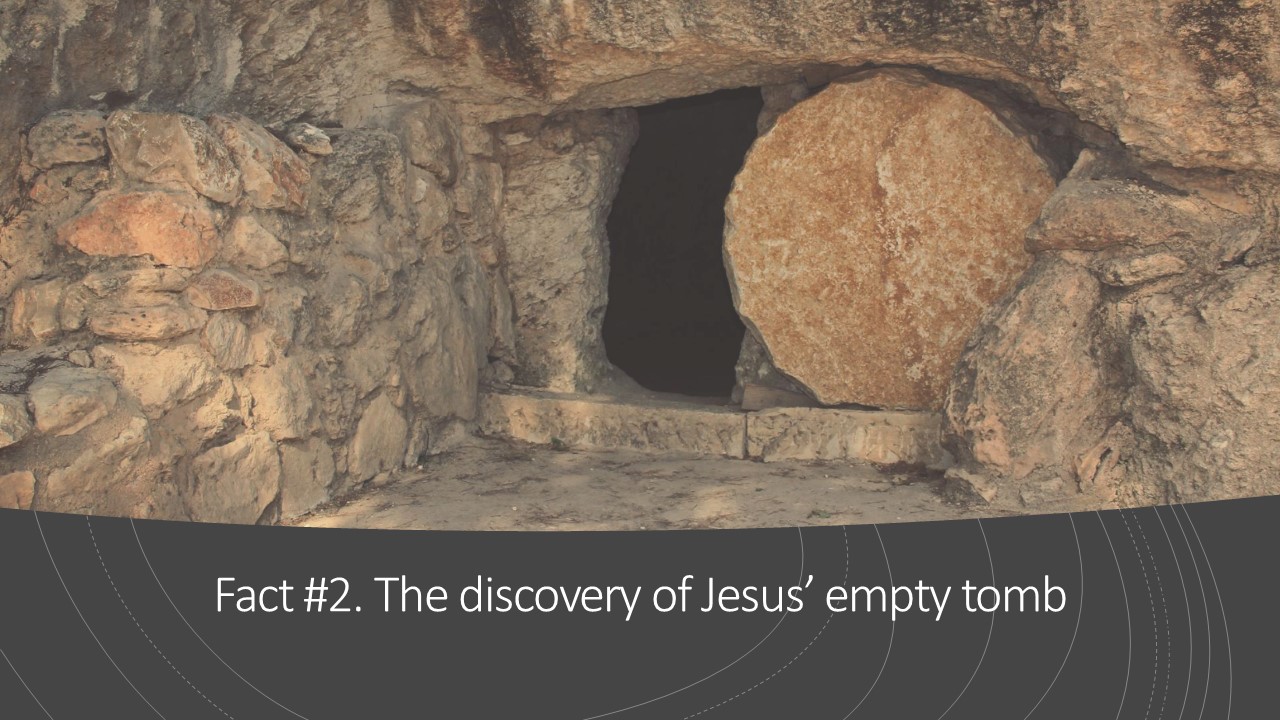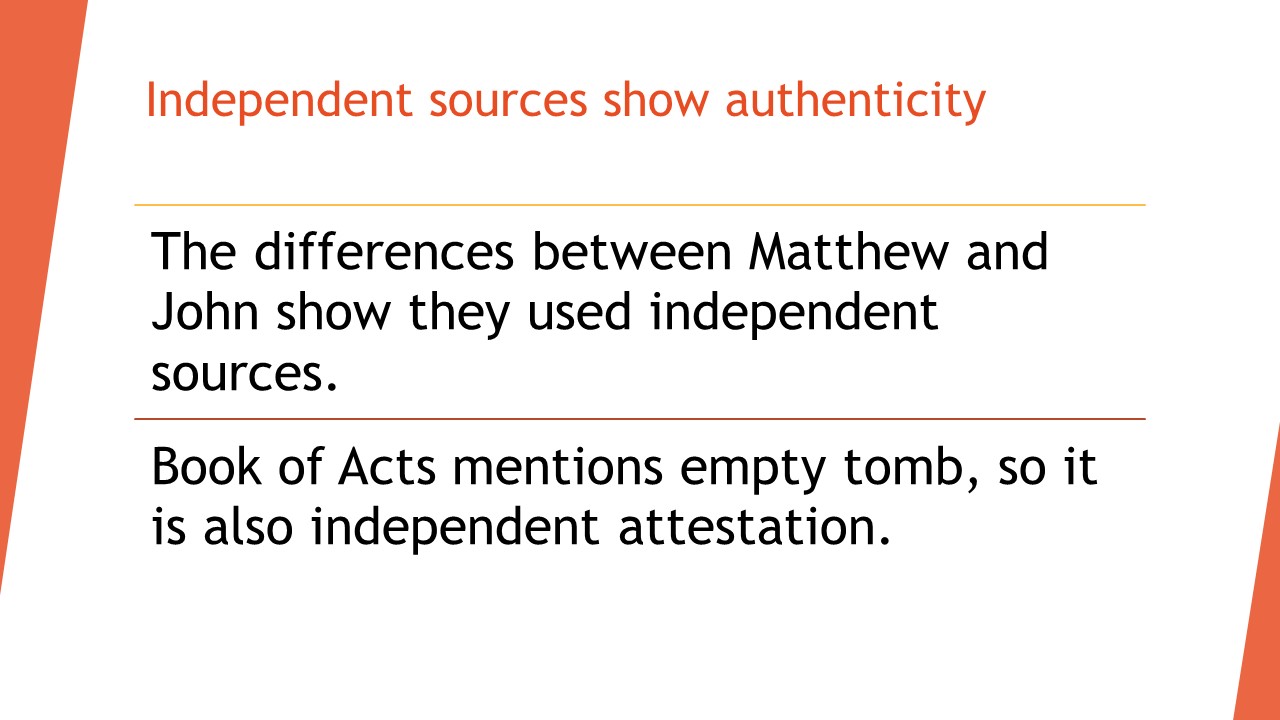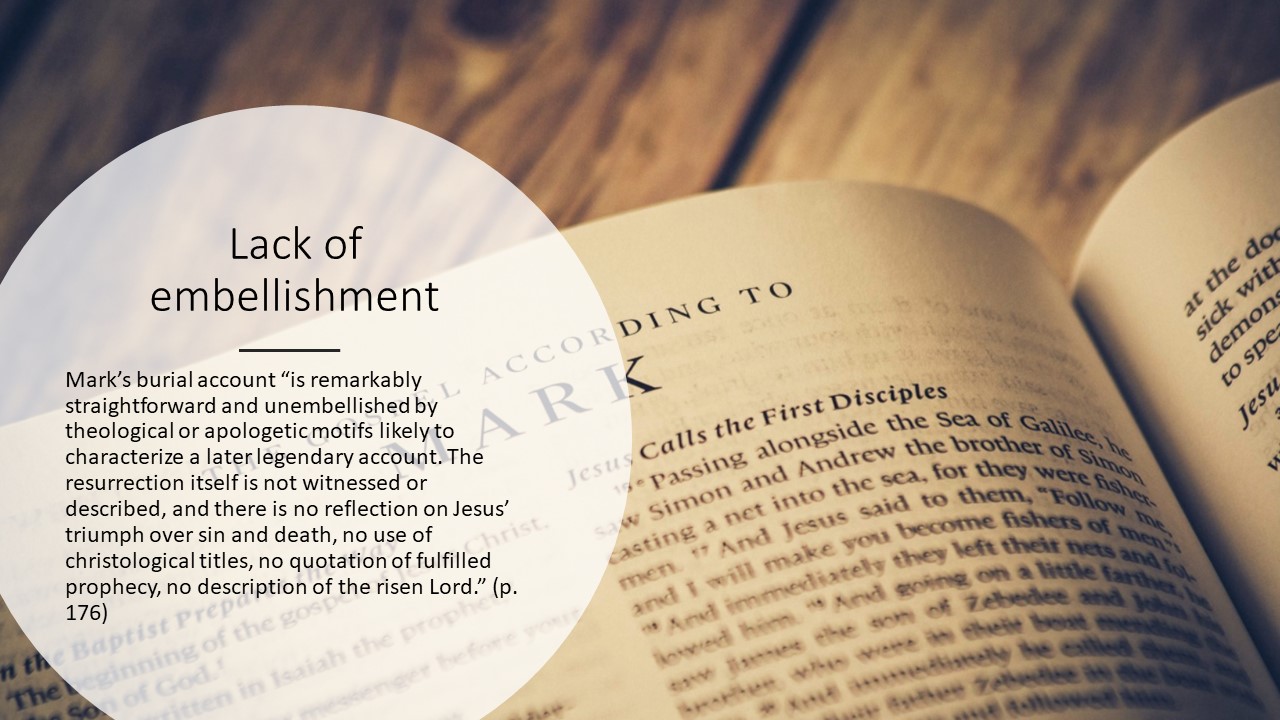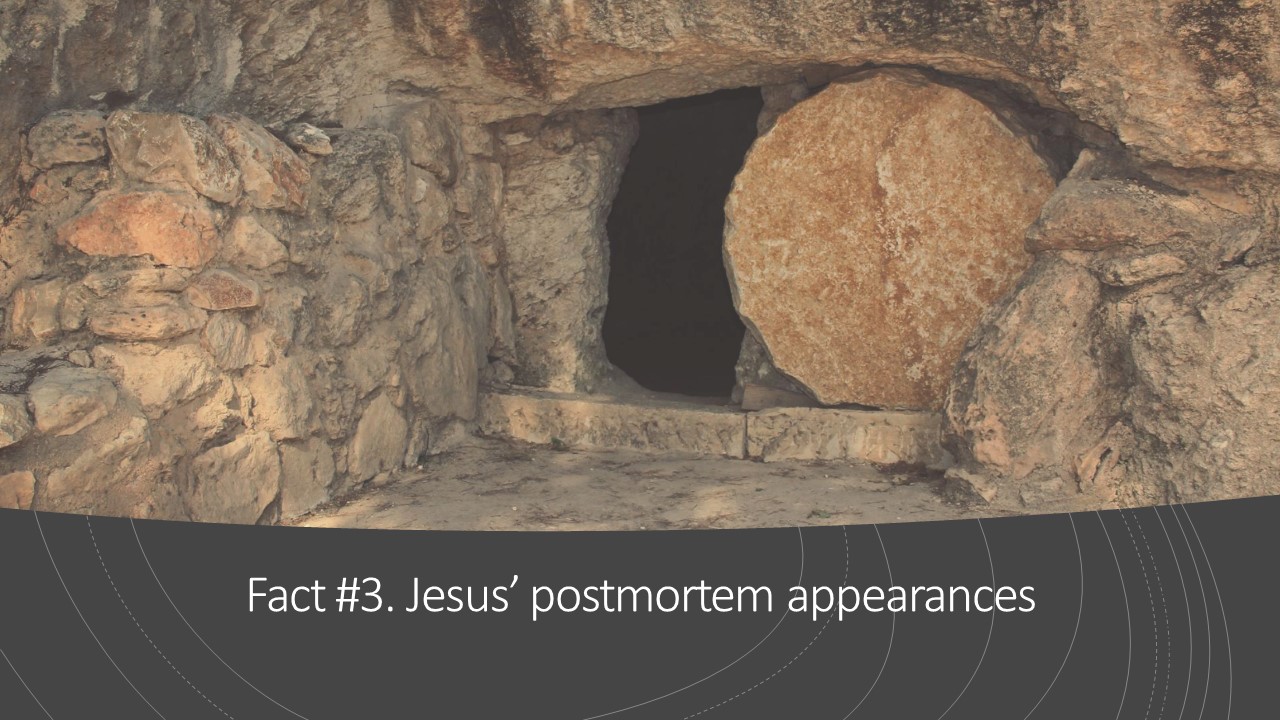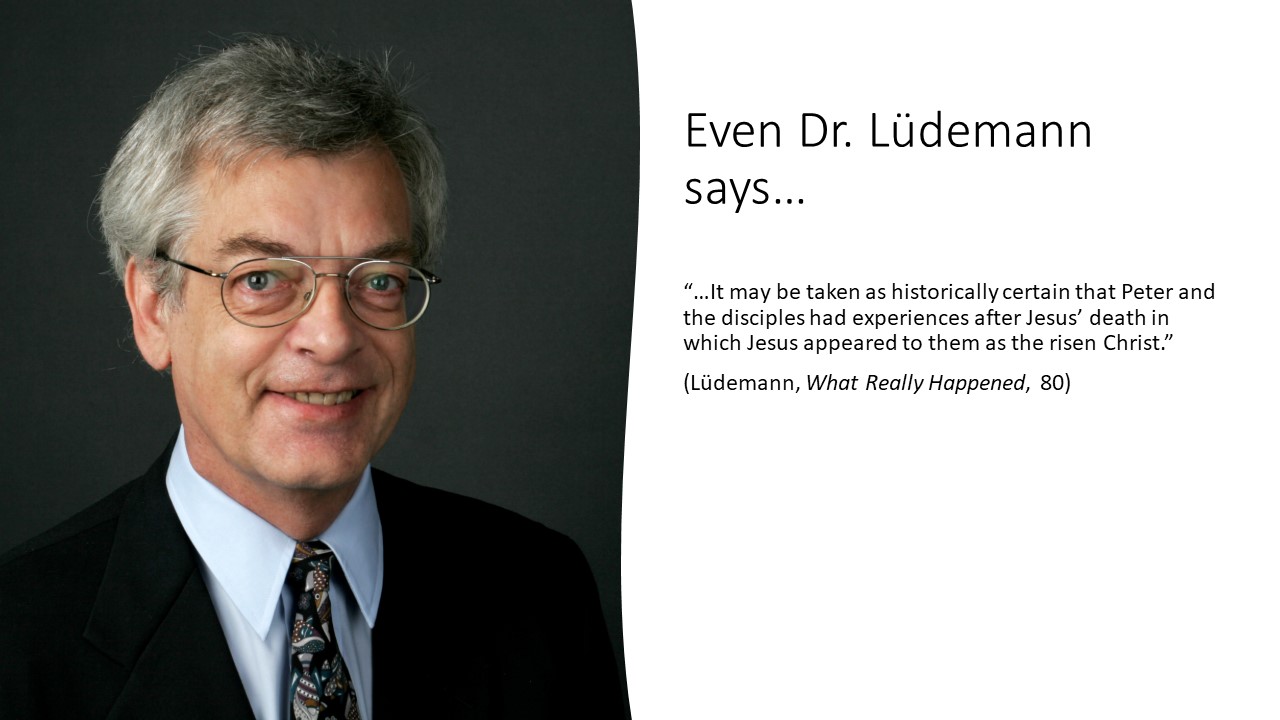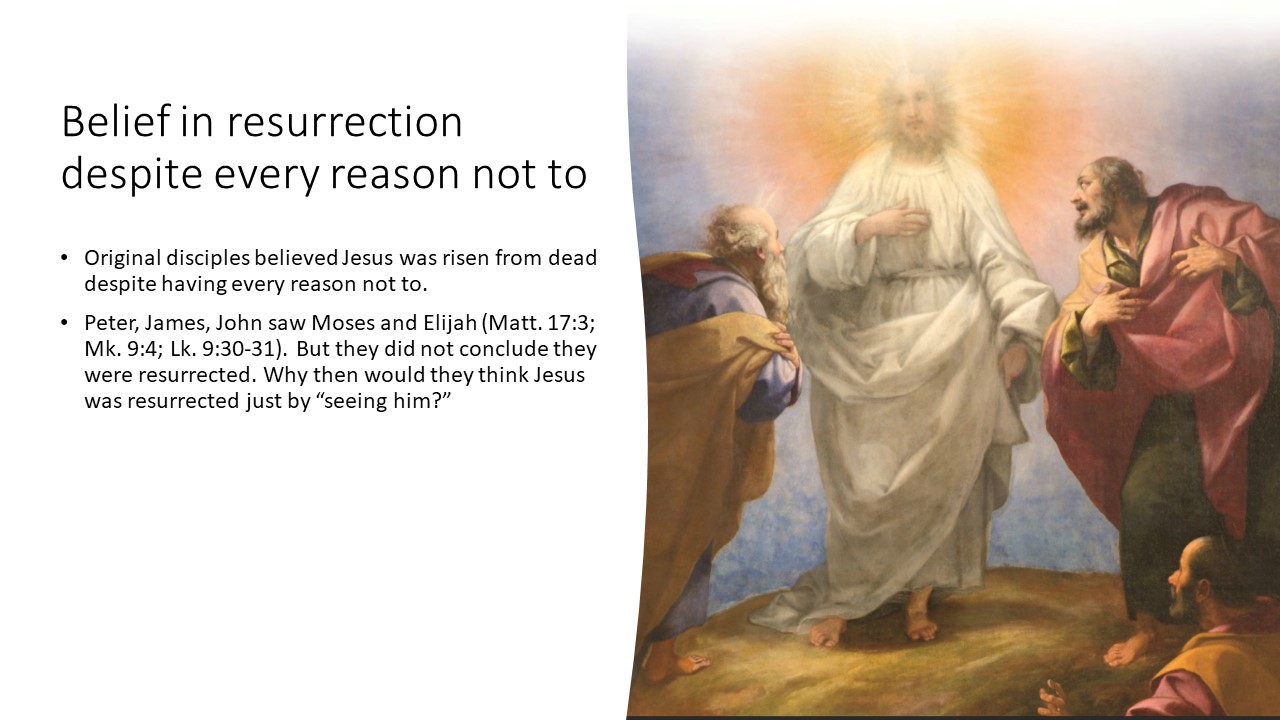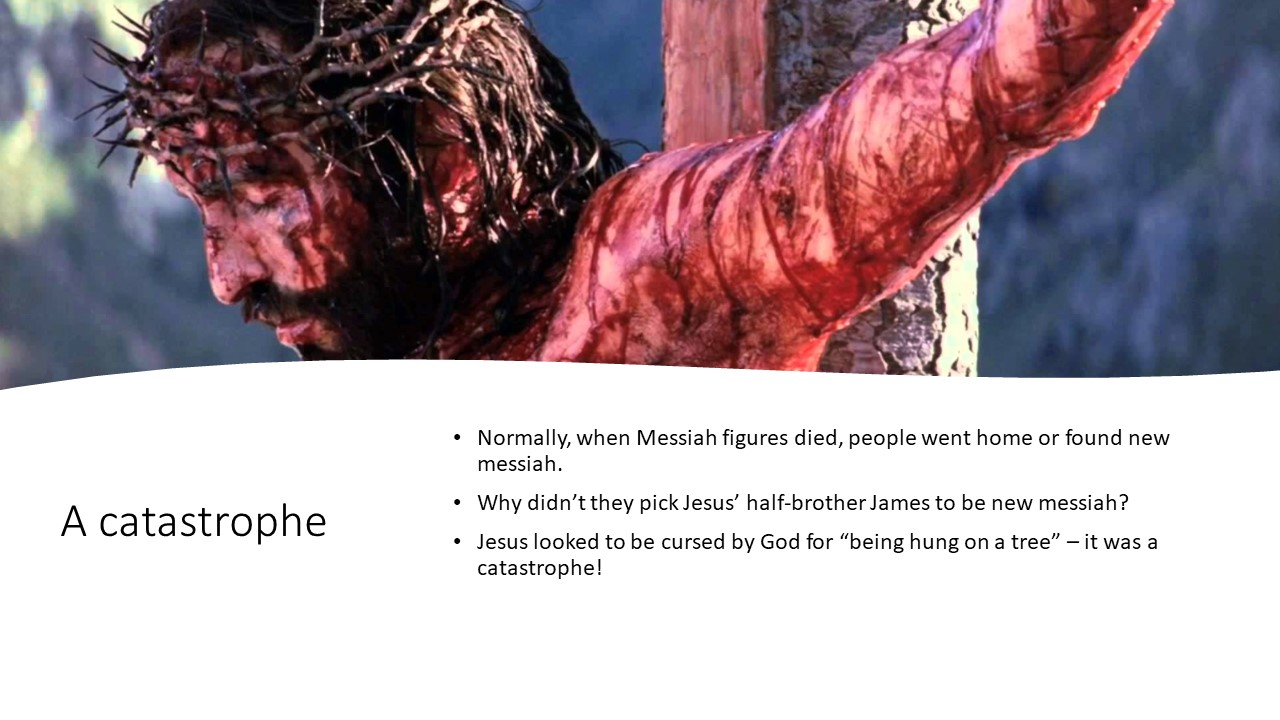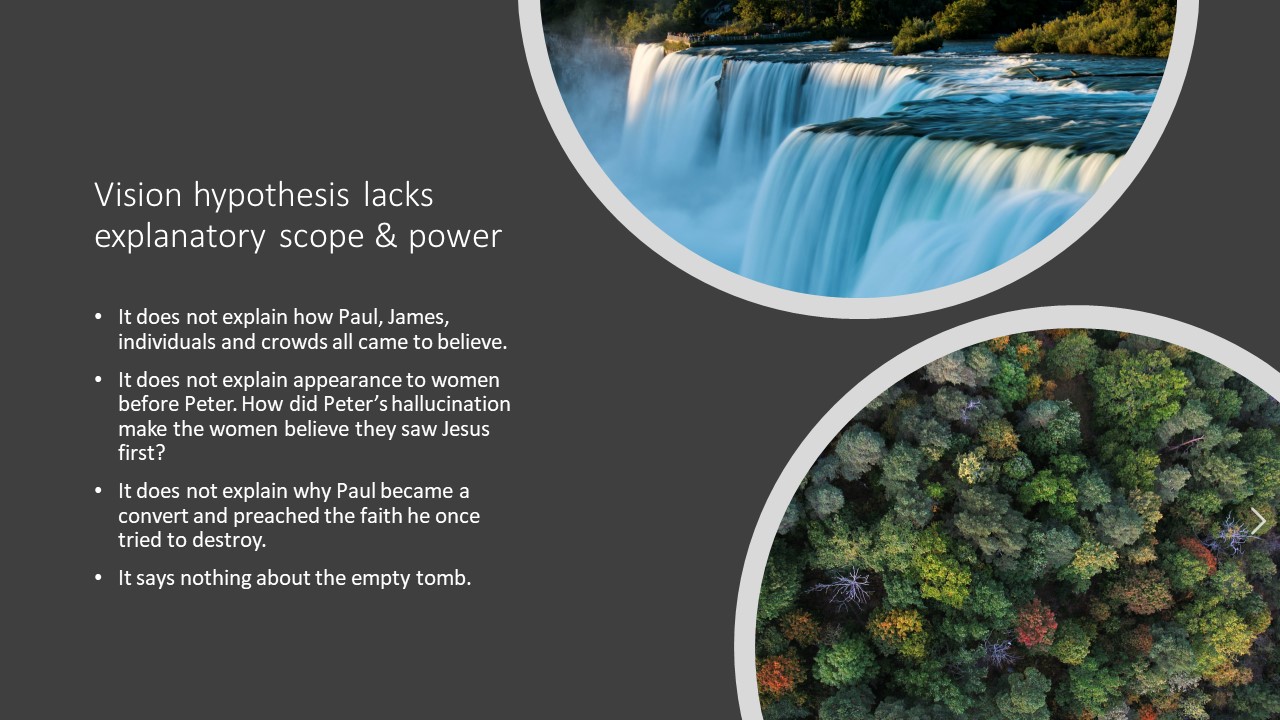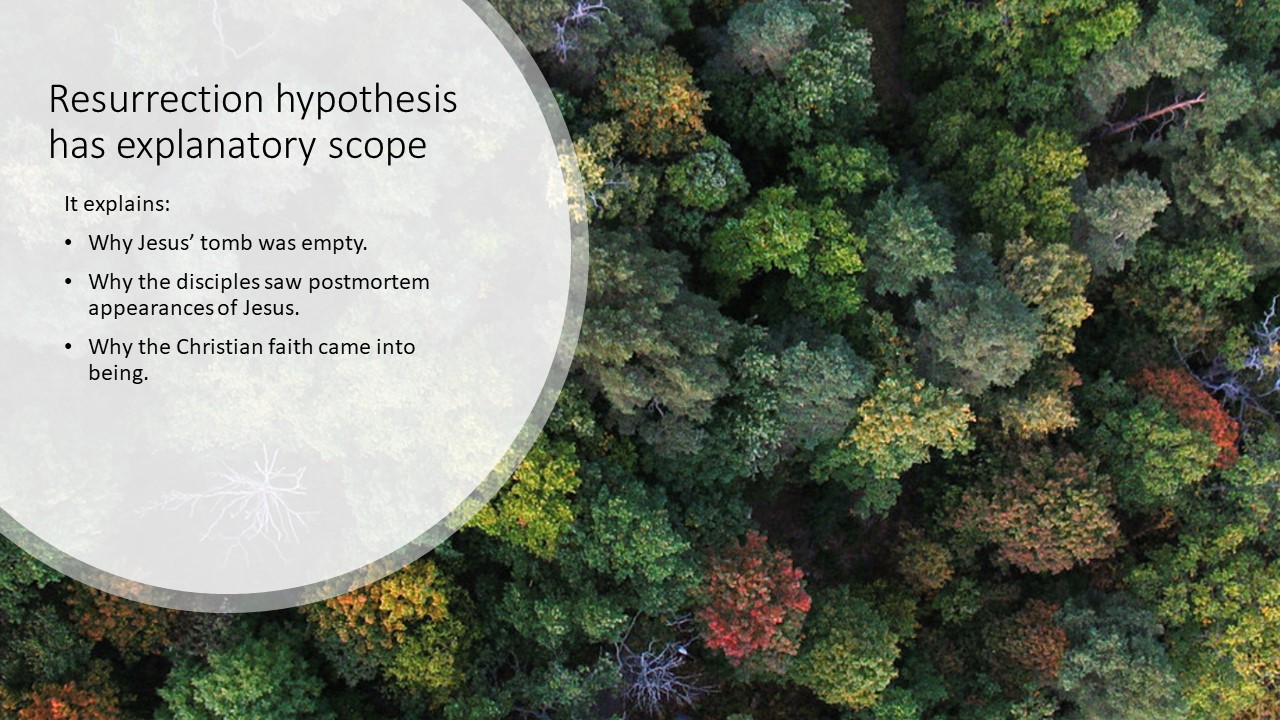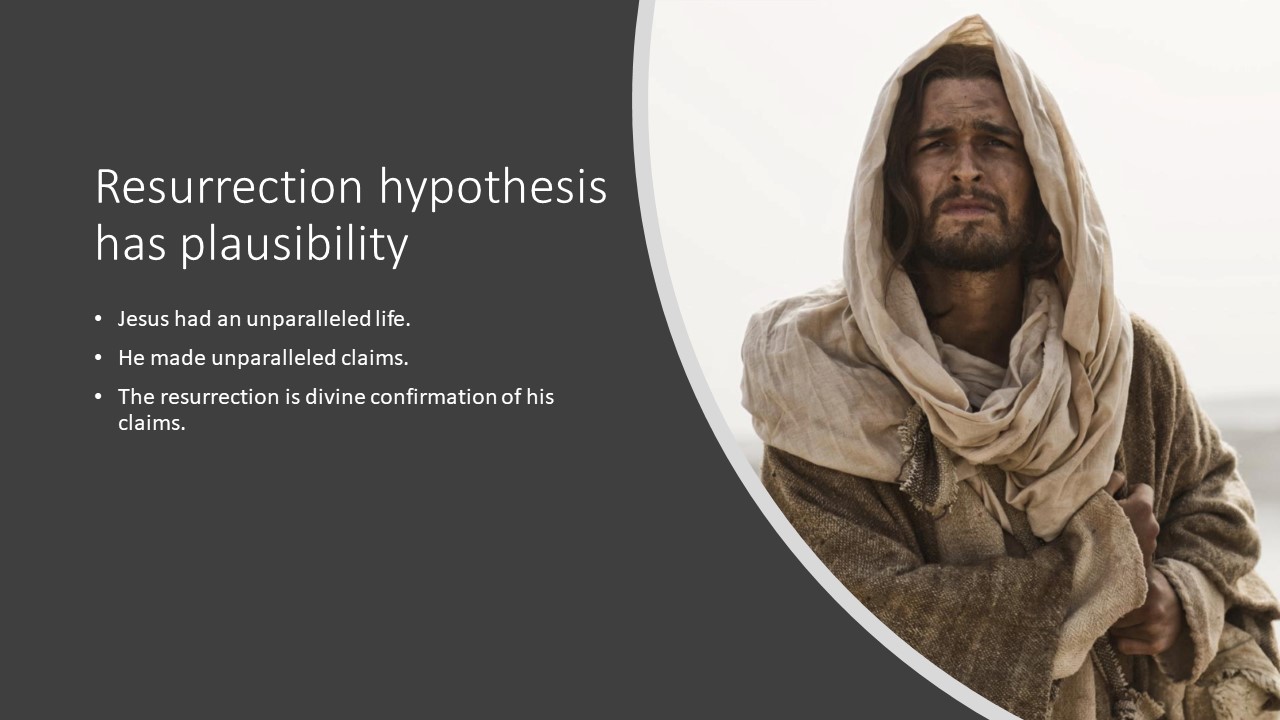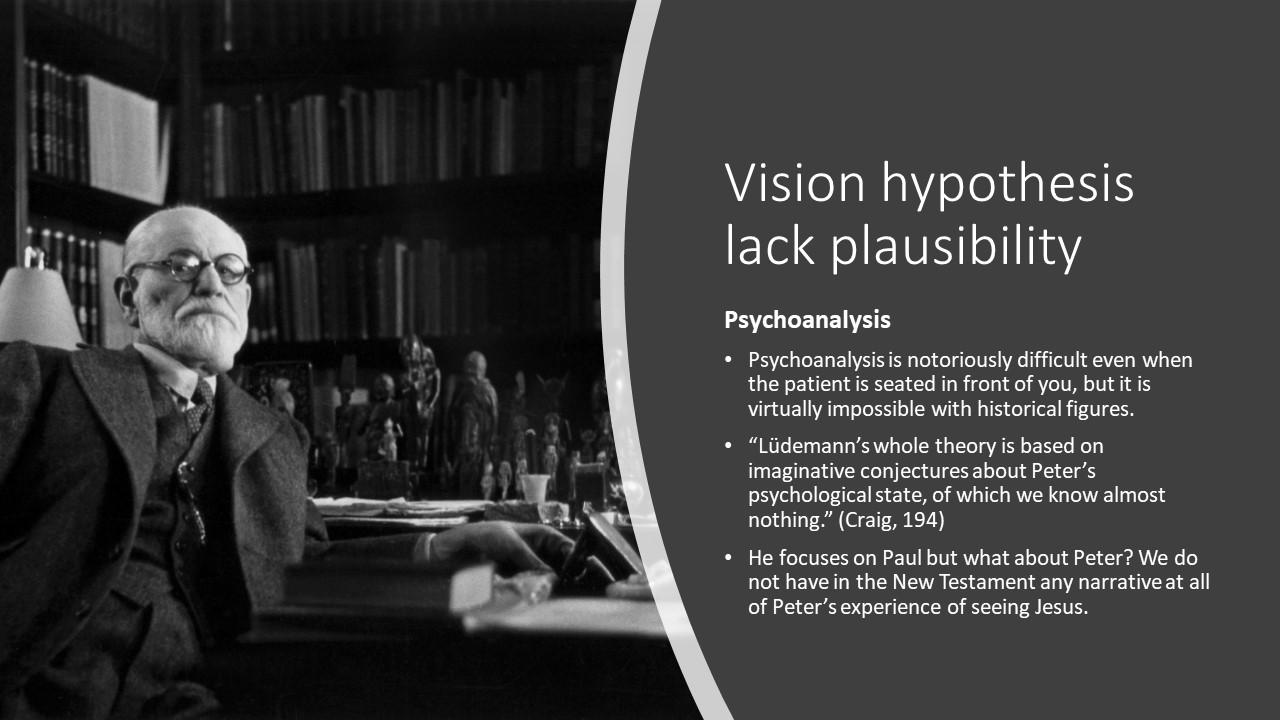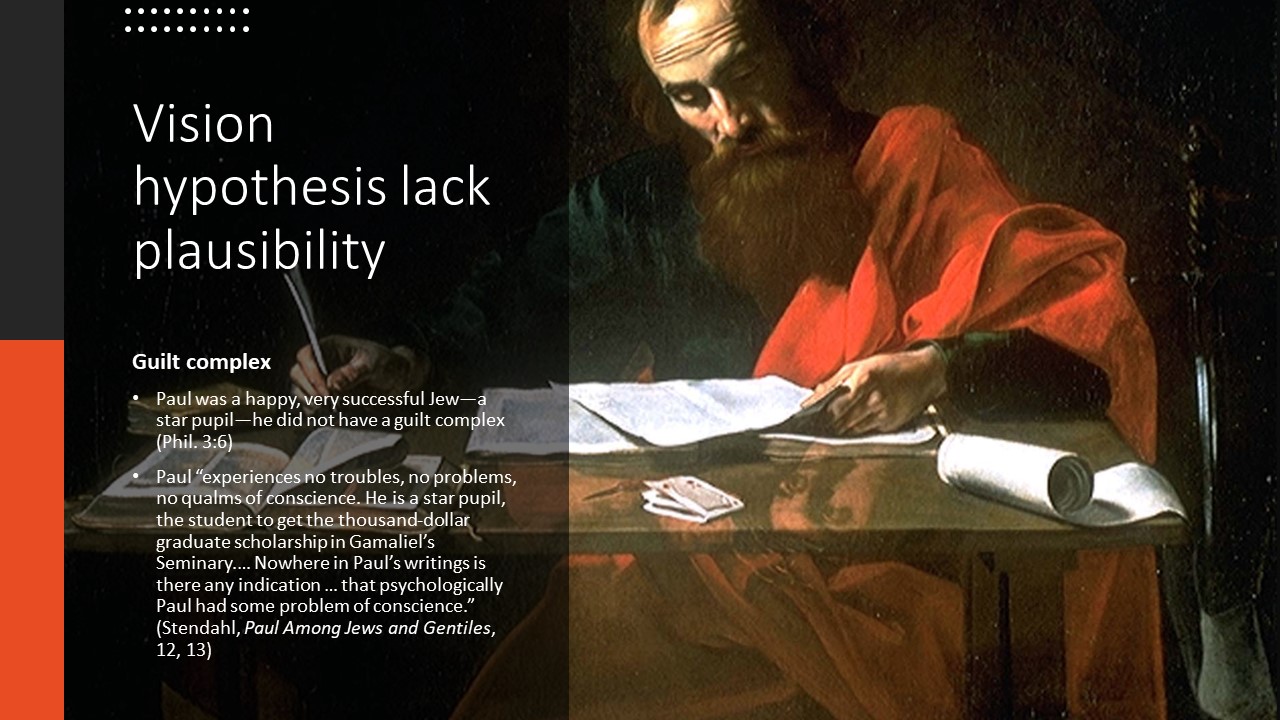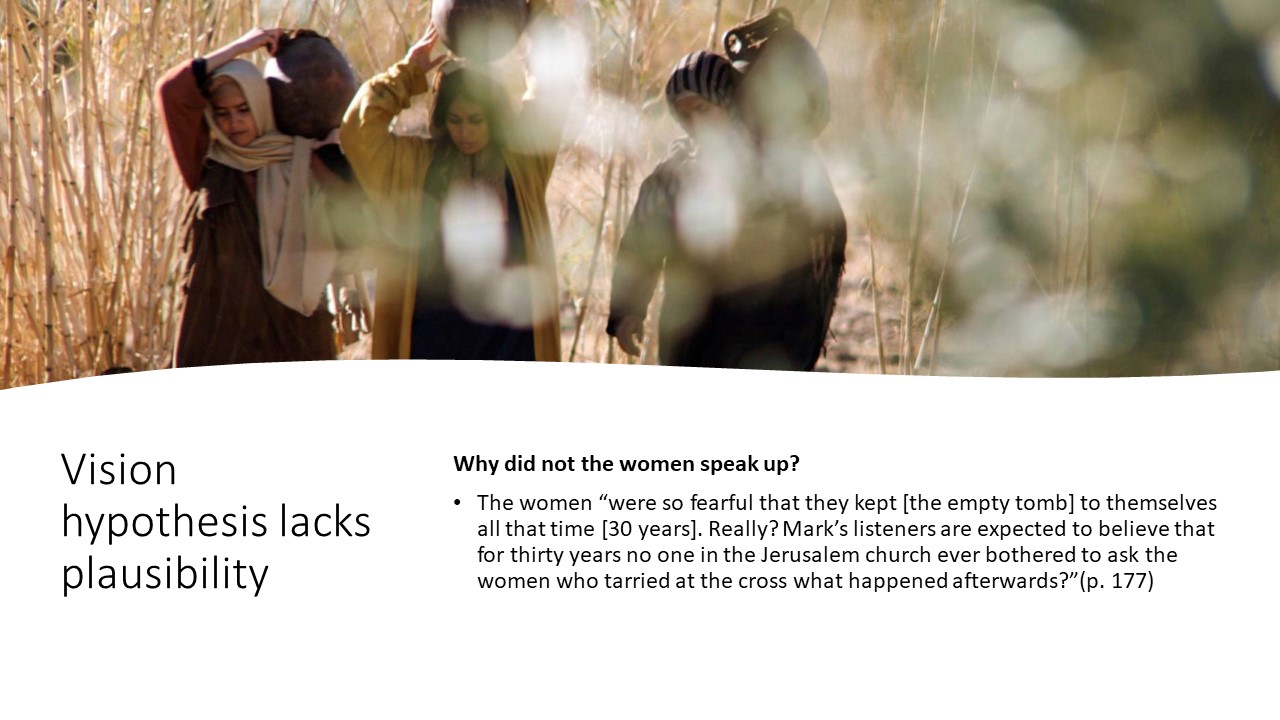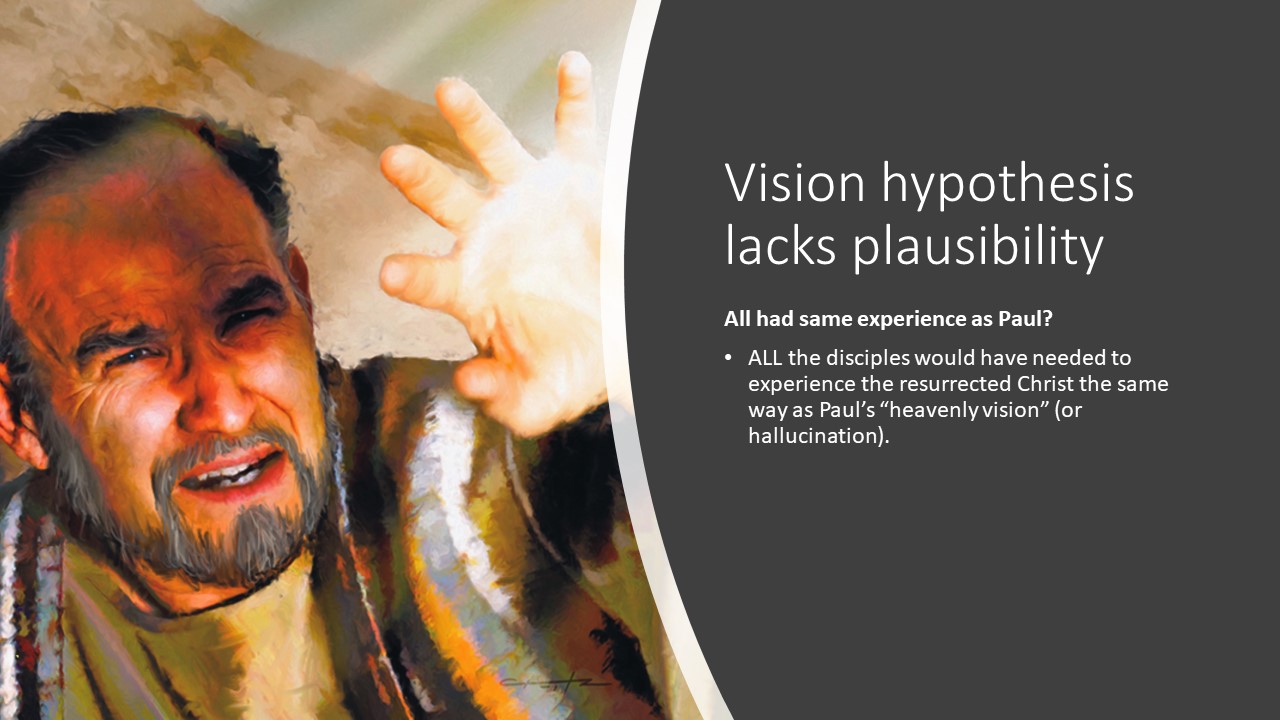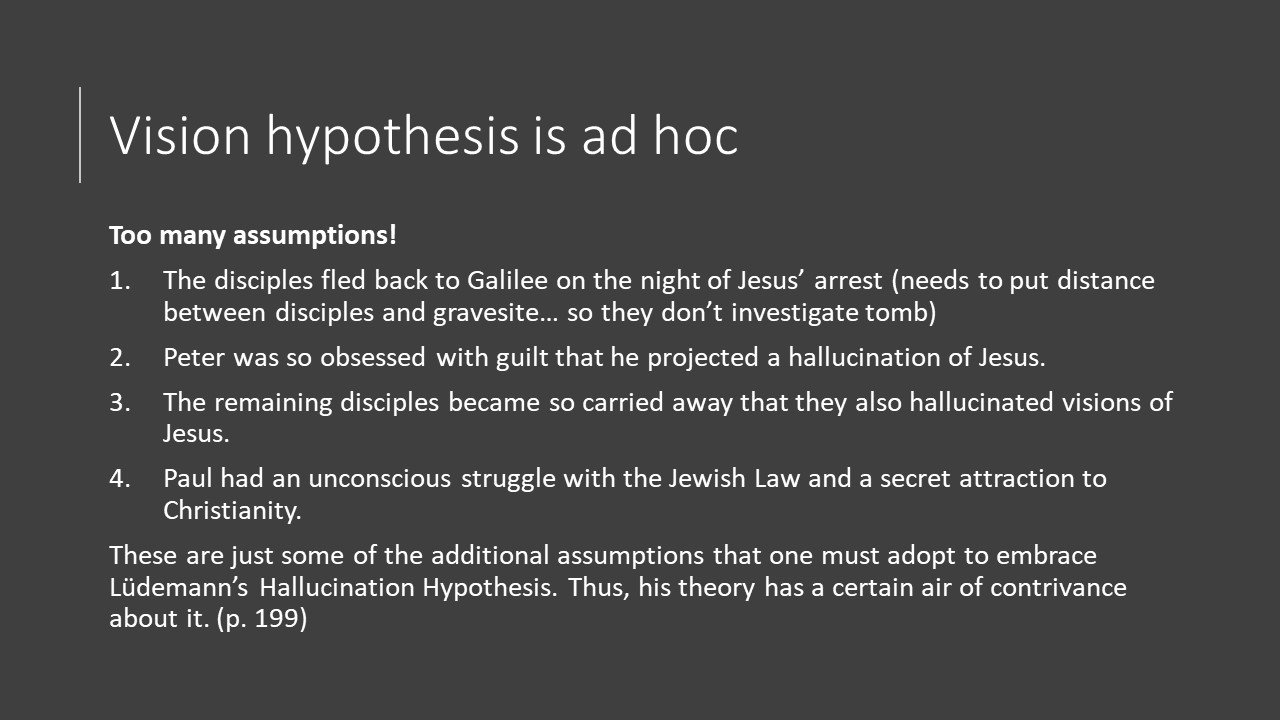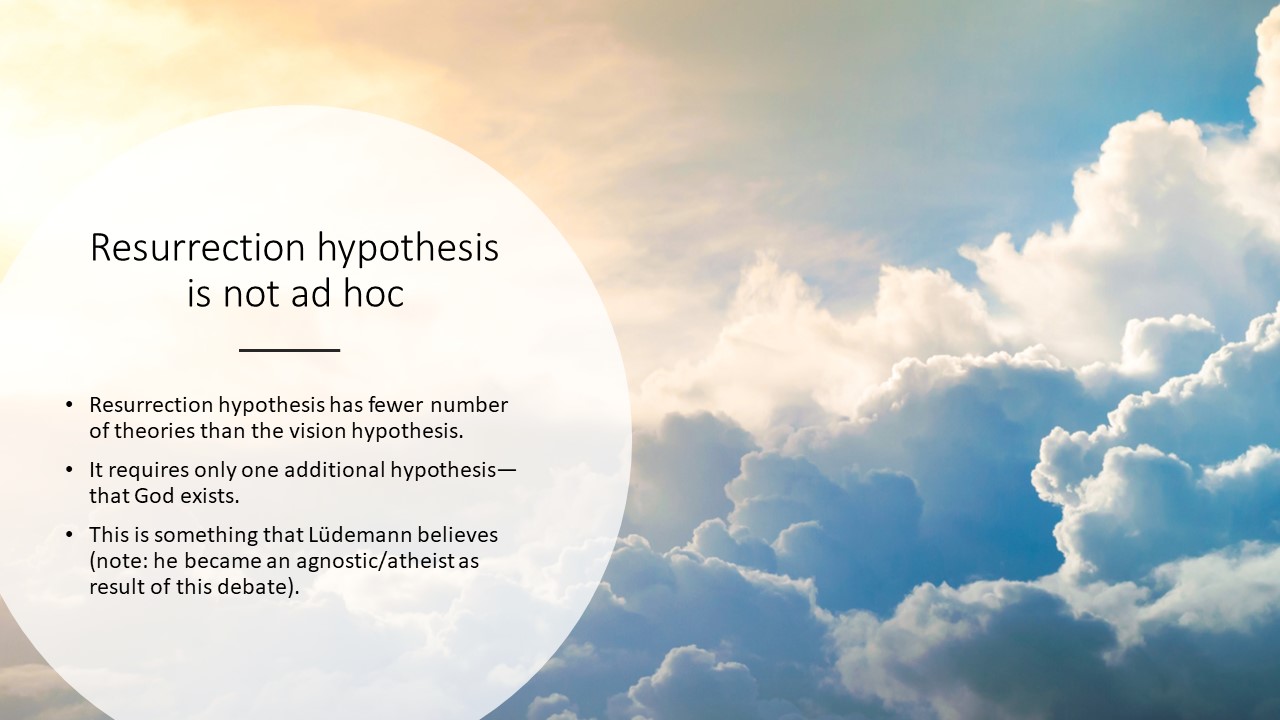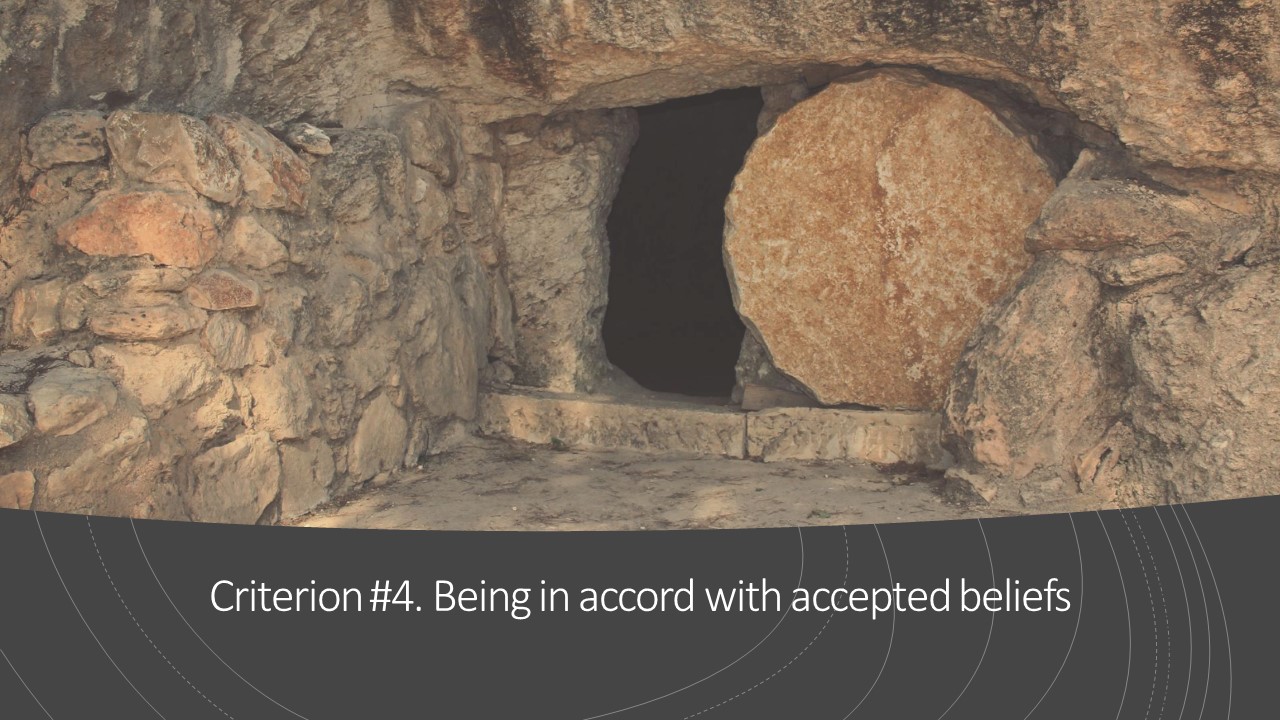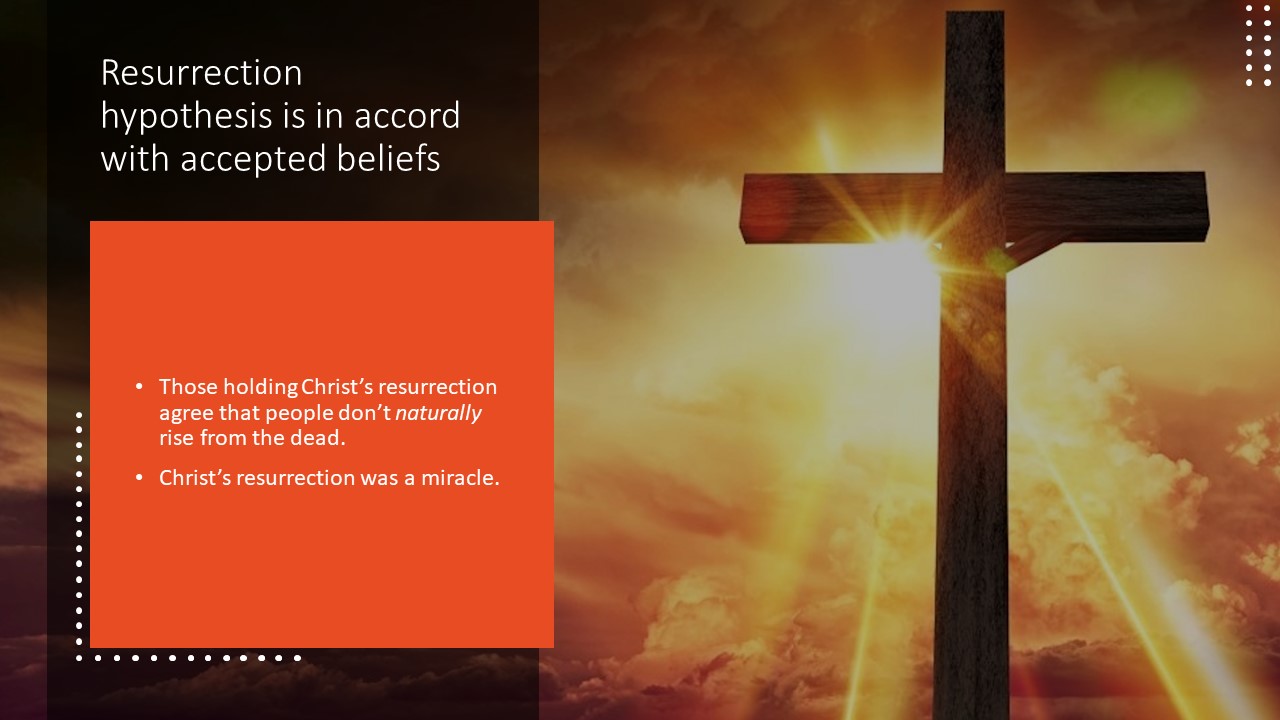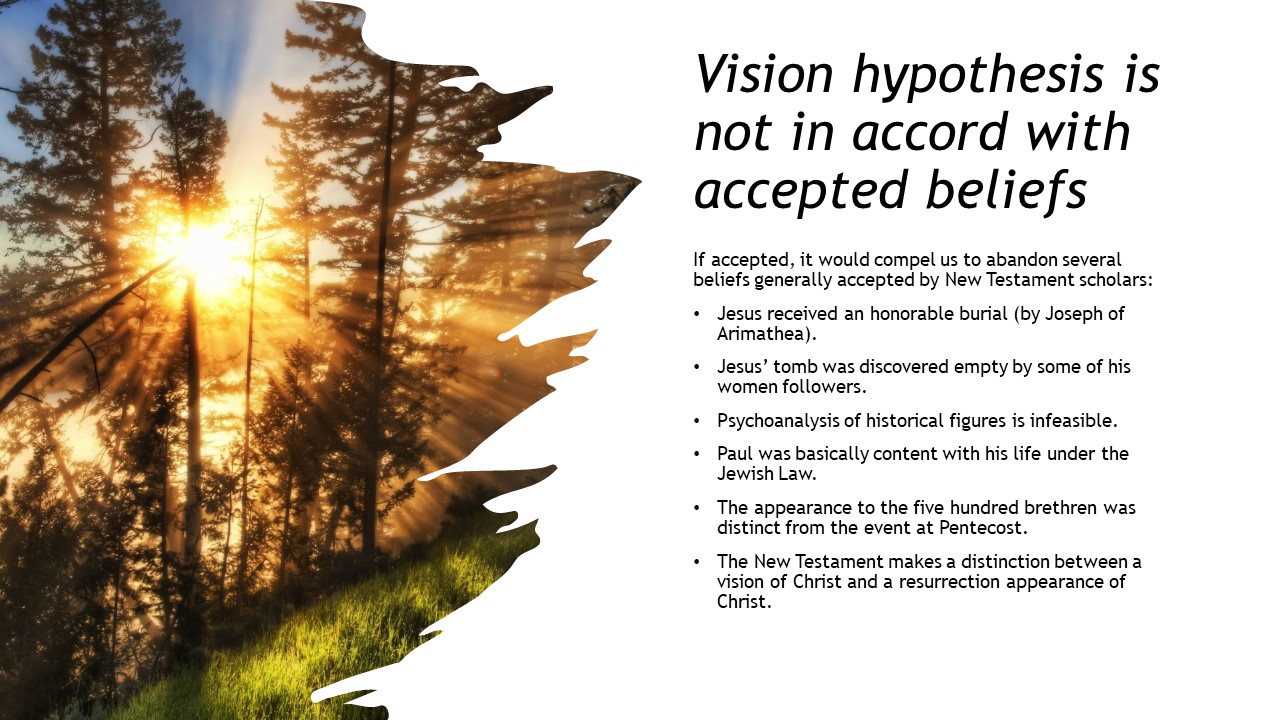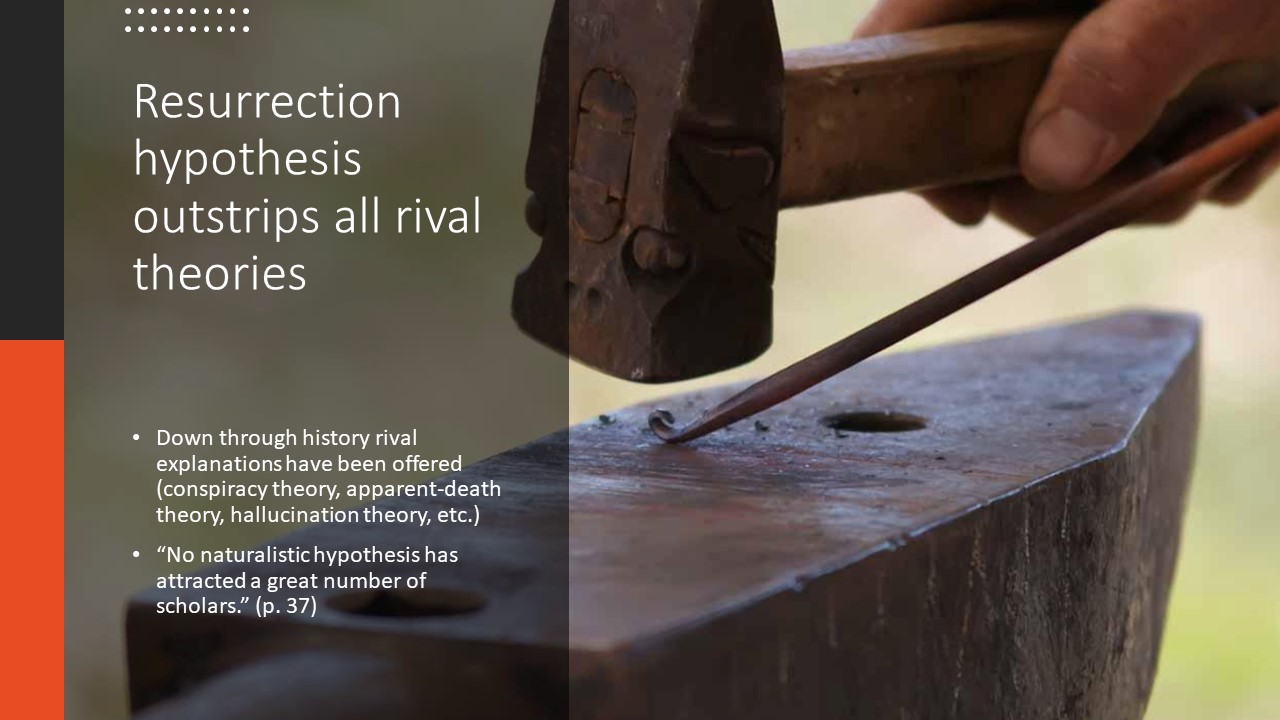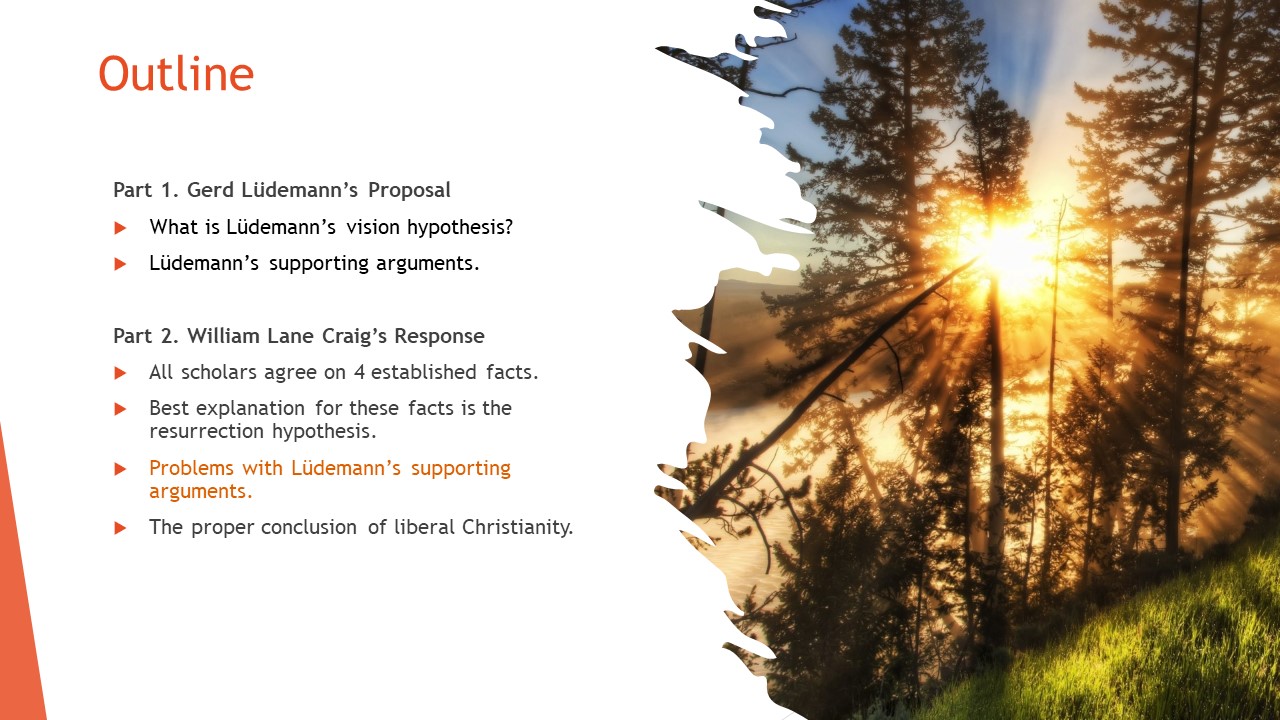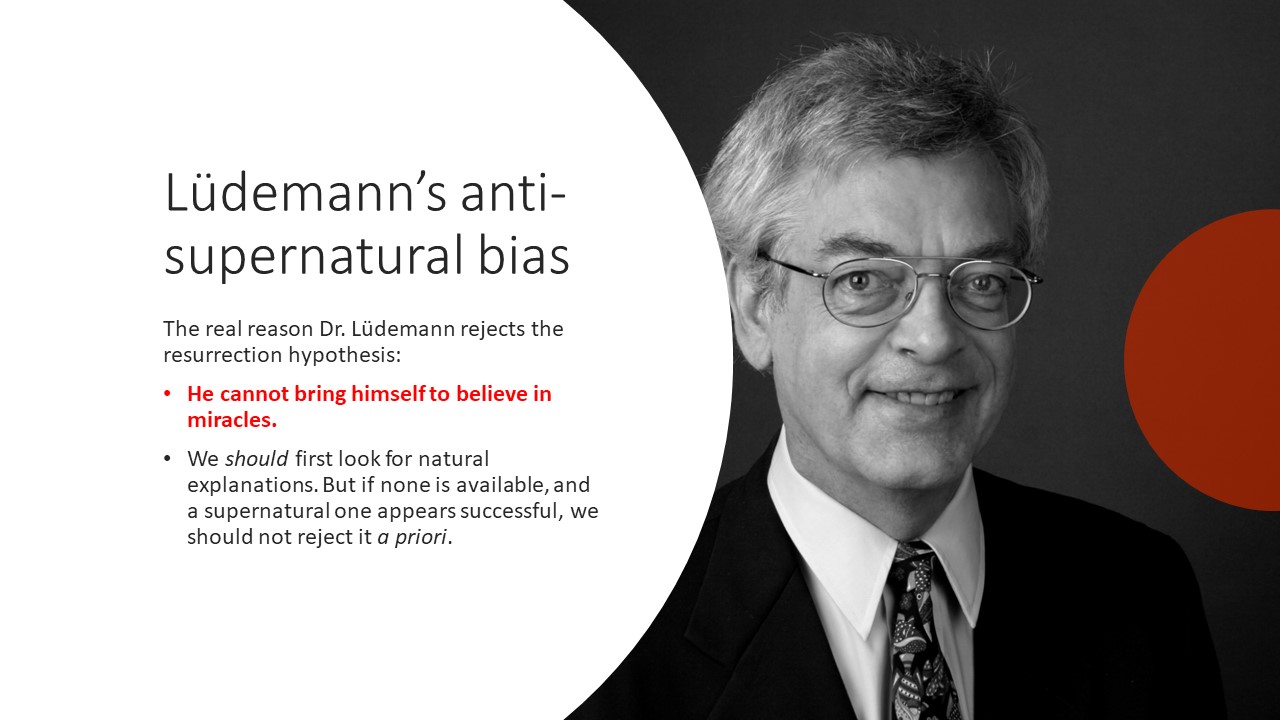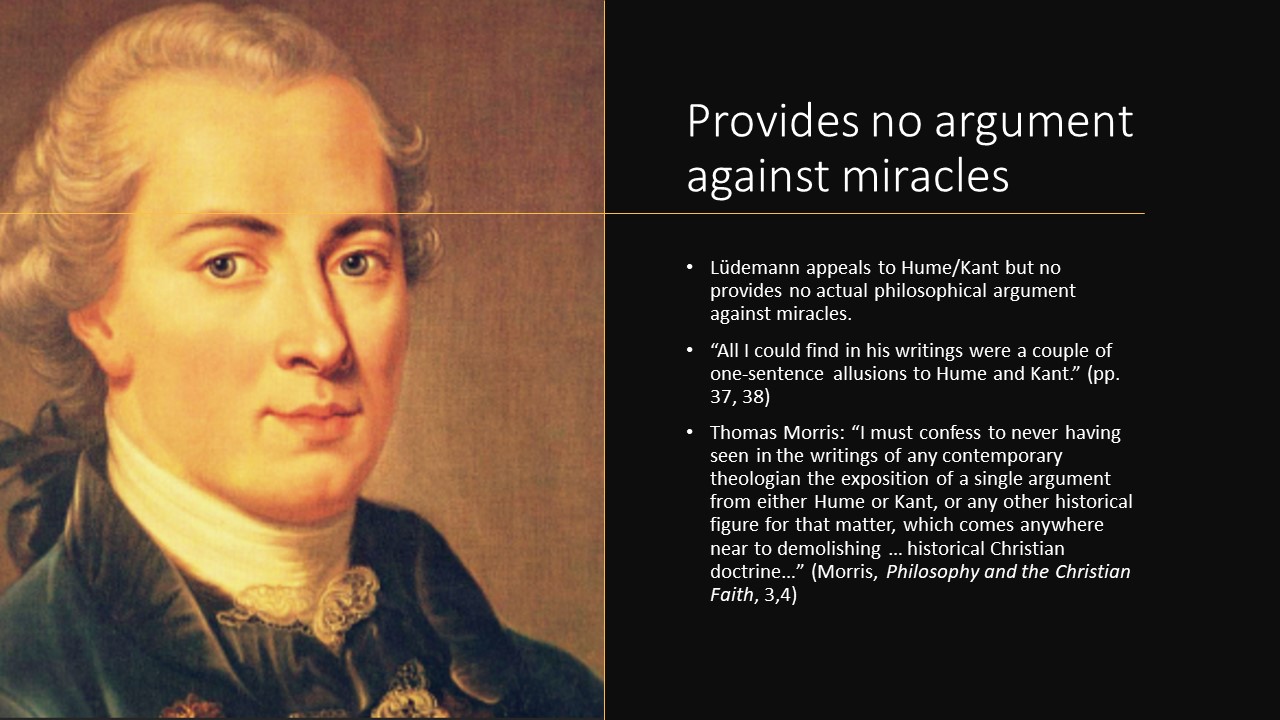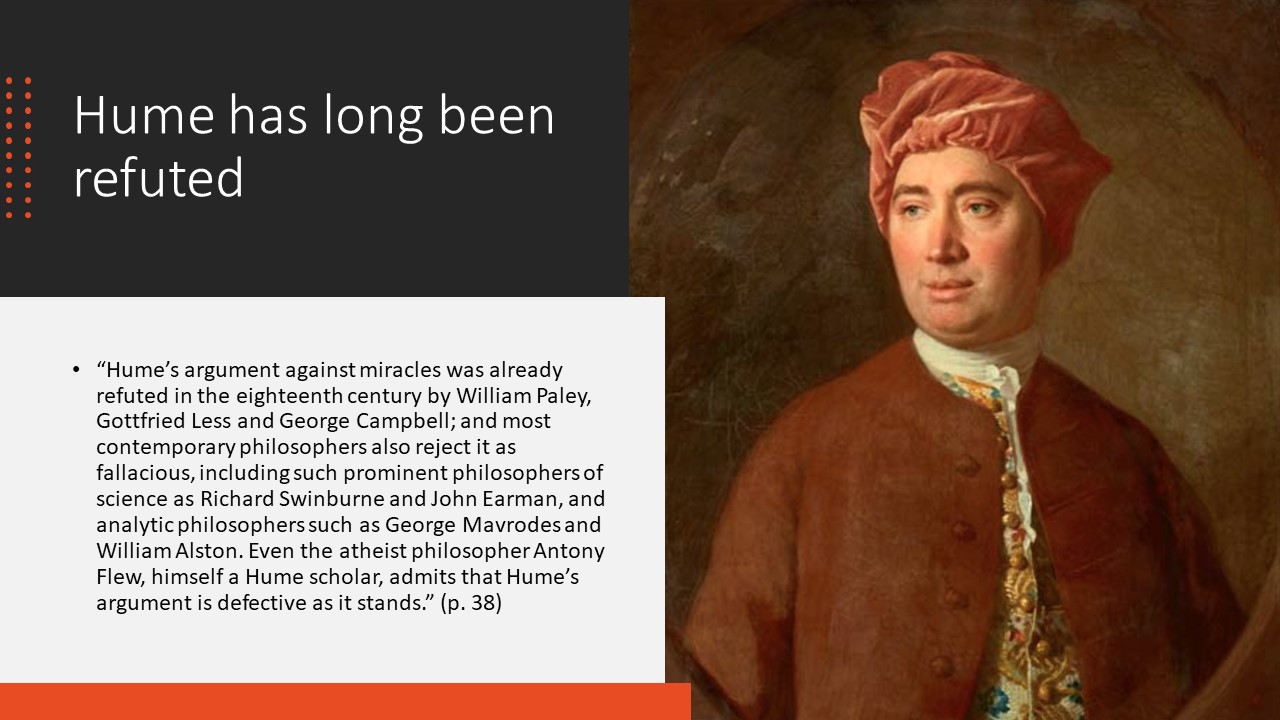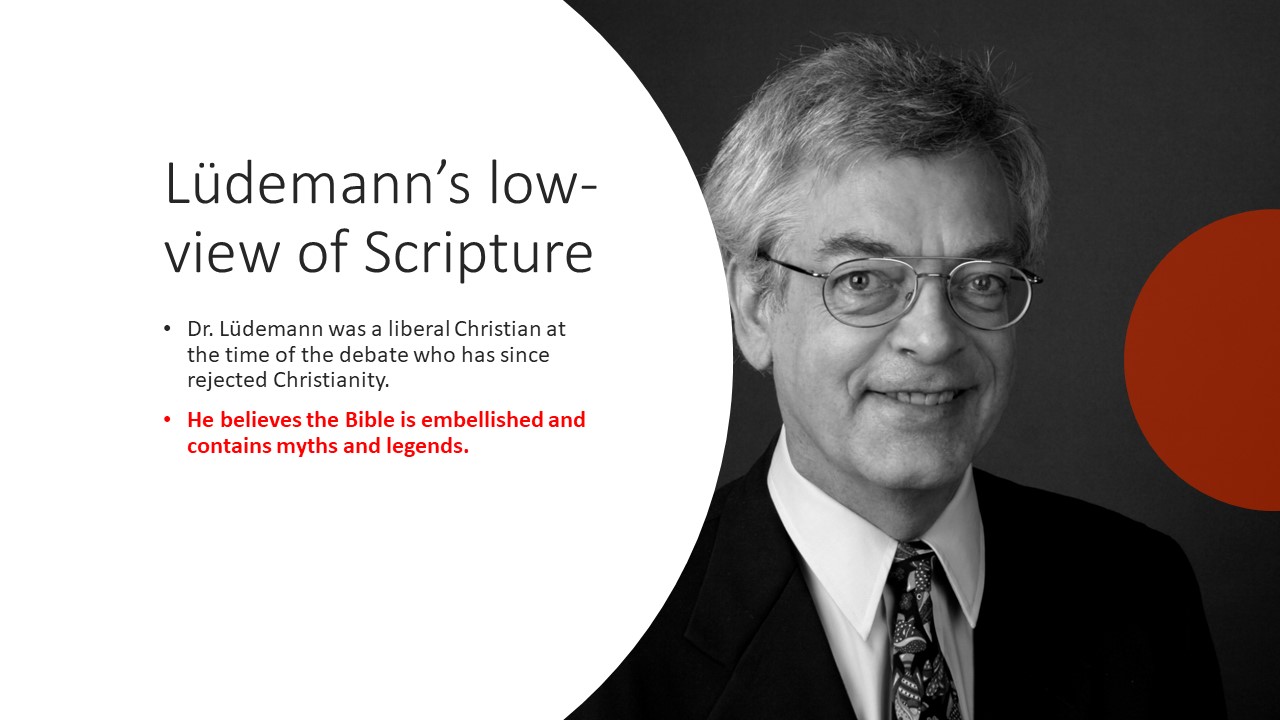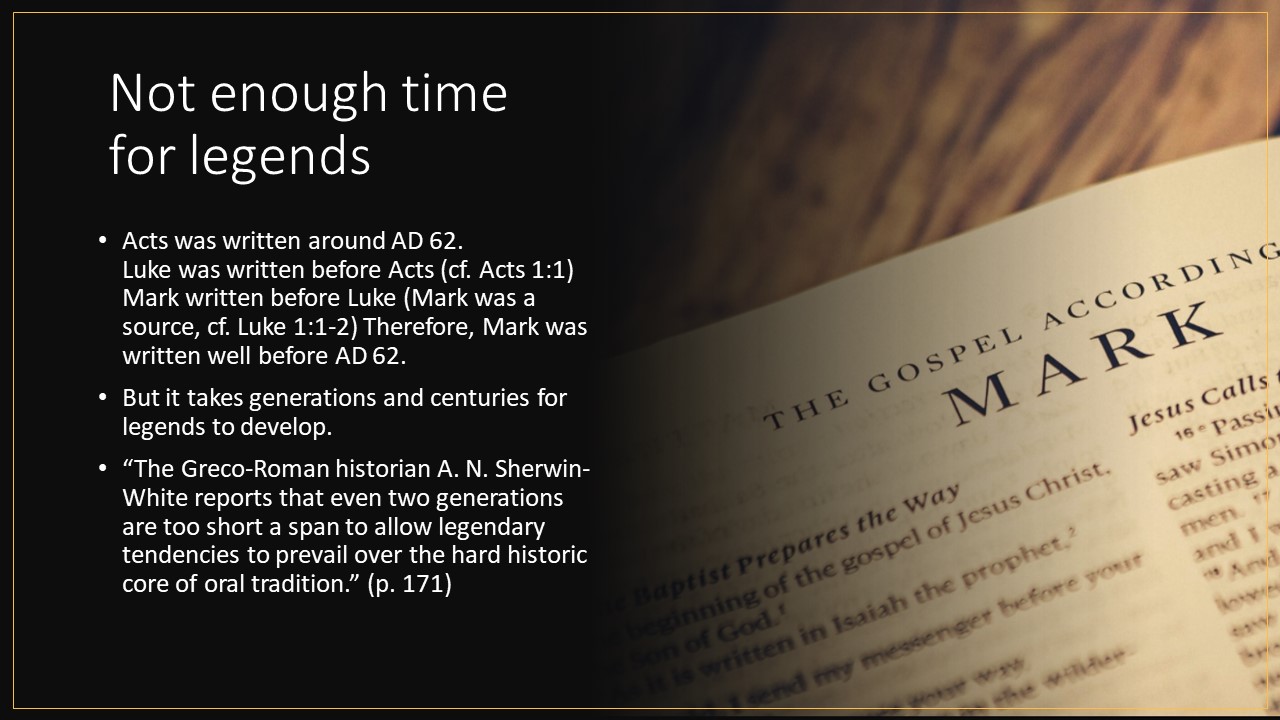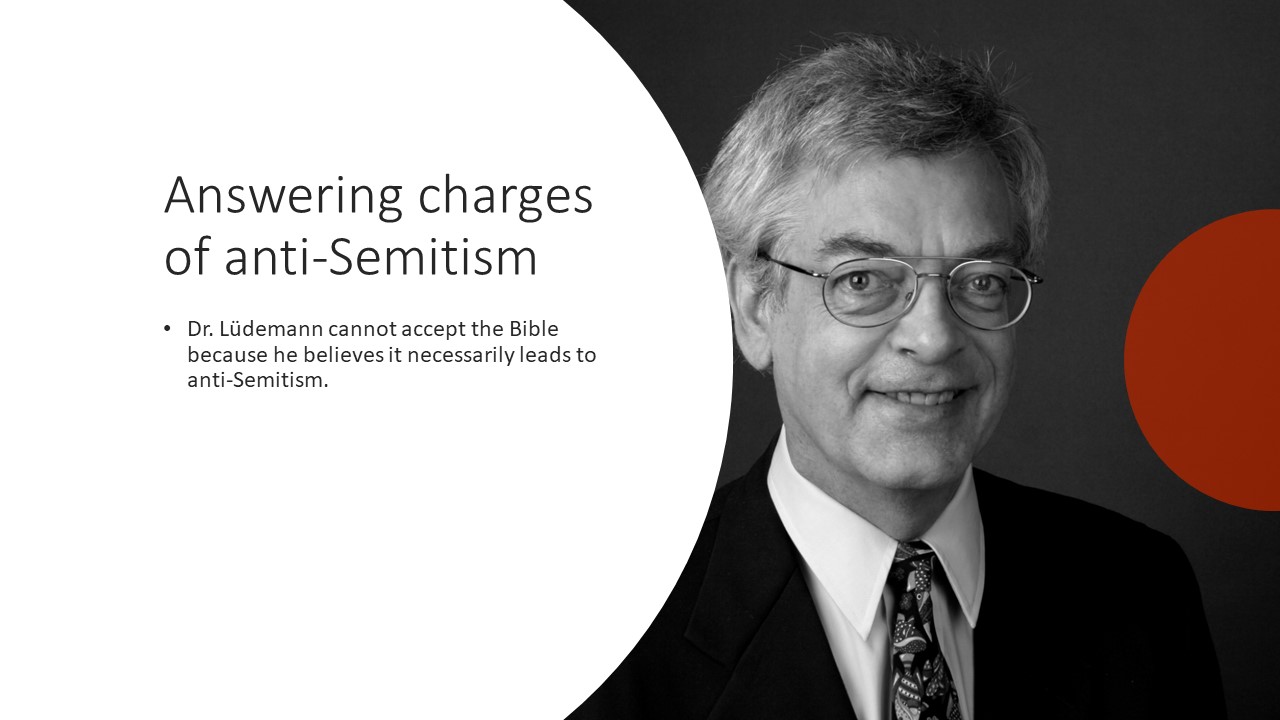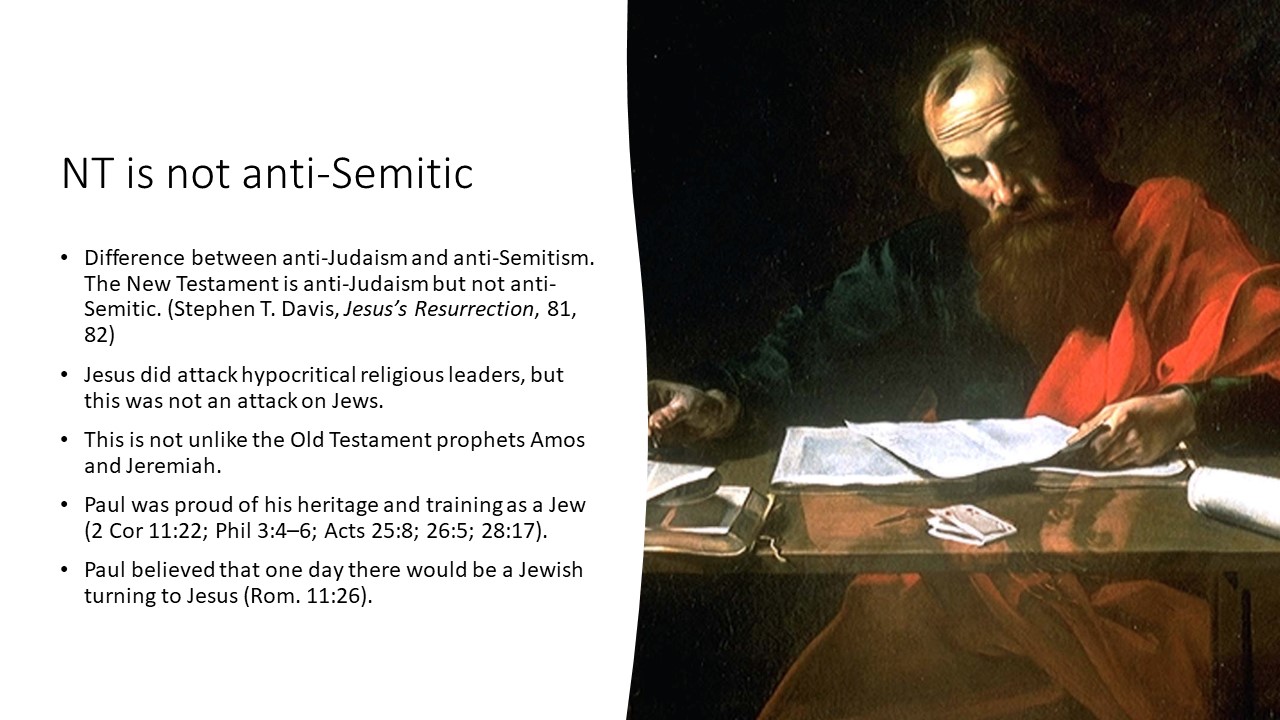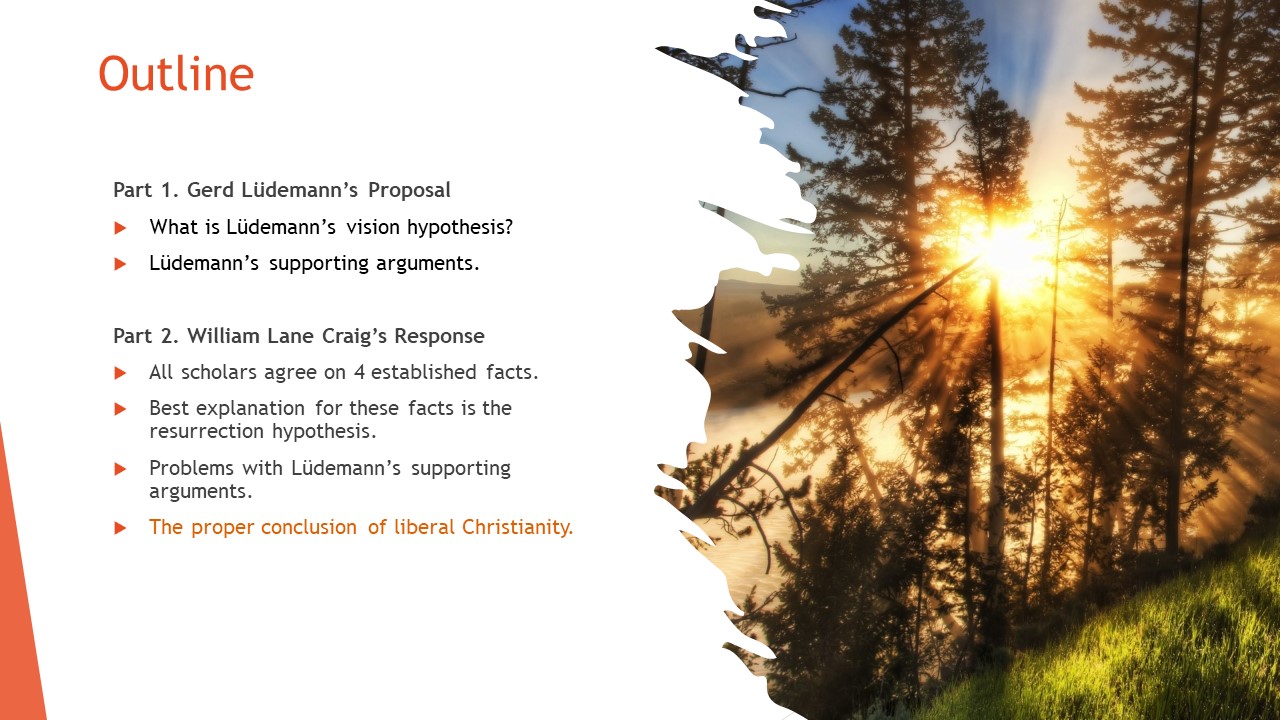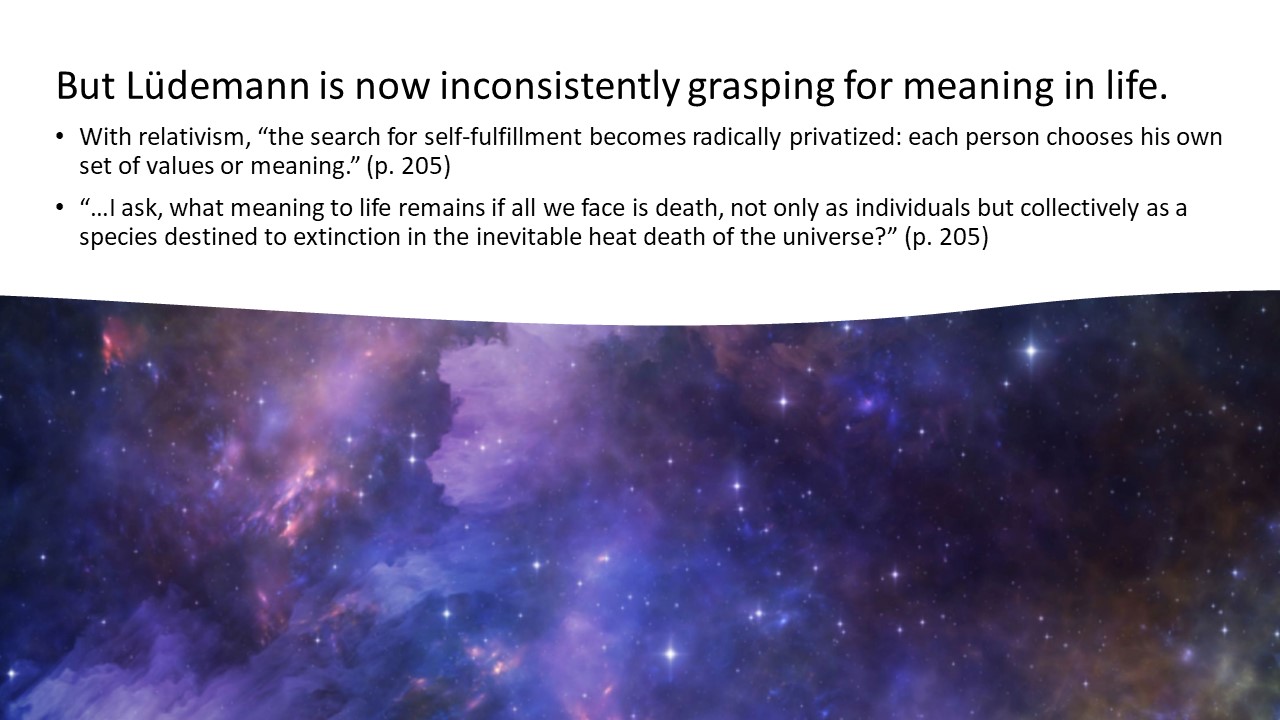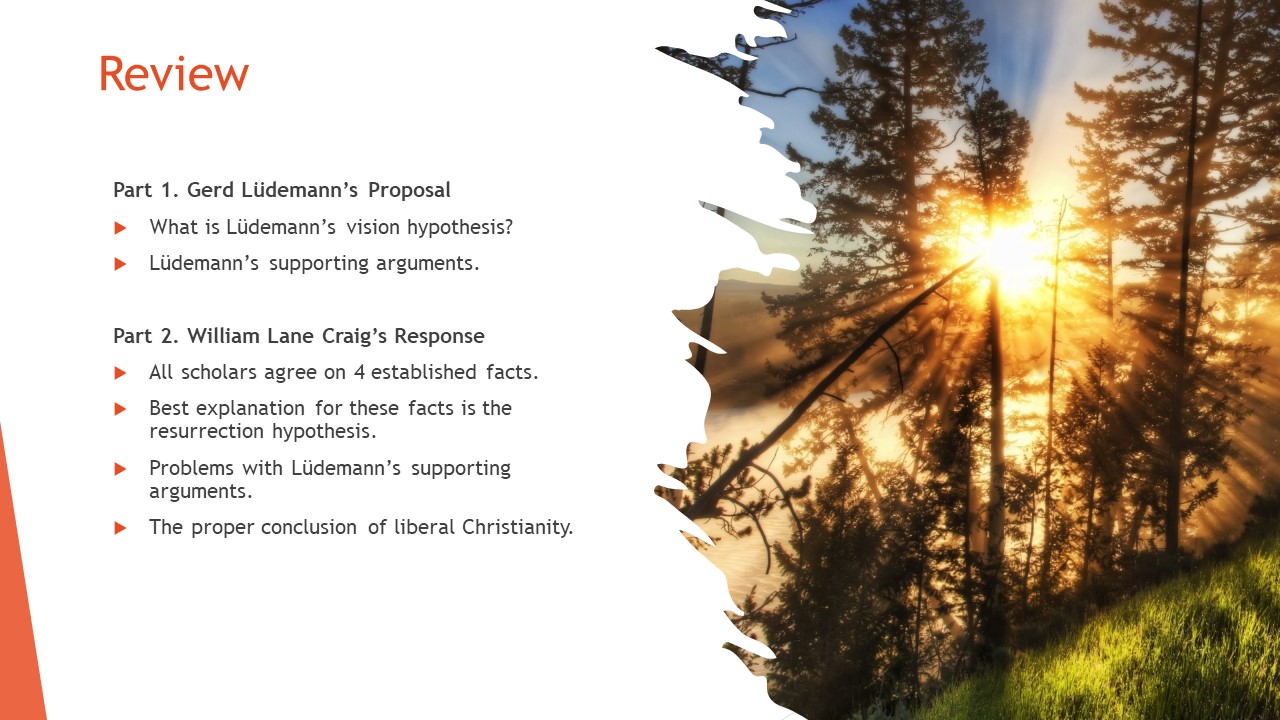Debunking The Vision Hypothesis Of The Resurrection
By Shawn Nelson
May 2020
This is a PowerPoint summary of the debate between William Lane Craig and Gerd Lüdemann regarding the vision hypothesis of Christ’s resurrection.
This presentation was in partial fulfillment of the requirements for the course titled History of Advanced Resurrection of Christ (AP906) taken at Veritas International University in May, 2020.
Copyright © 2020 Shawn Nelson.
Debunking The Vision Hypothesis Of The Resurrection
A Summary Of The Debate Between William Lane Craig & Gerd Lüdemann
Outline
Part 1. Gerd Lüdemann’s Proposal
• What is Lüdemann’s vision hypothesis?
• Lüdemann’s supporting arguments.
Part 2. William Lane Craig’s Response
• All scholars agree on 4 established facts.
• Best explanation for these facts is the resurrection hypothesis.
• Problems with Lüdemann’s supporting arguments.
• The proper conclusion of liberal Christianity.
Part 1. Gerd Lüdemann’s Proposal
Vision hypothesis
Guilt complex
• Peter had guilt complex for denying Christ three times.
• So Peter hallucinated Jesus.
• This led to chain reaction among other disciples—and they also hallucinated.
Contagious
• All the disciples abandoned Jesus in his hour of need.
• They were all liable to dramatic and traumatic experiences.
• Such experiences can be “contagious” for those who hear about such conversions.
Paul
Earliest account was vision
• Paul’s account in 1 Corinthians 15 is the earliest (and therefore most reliable) account.
• Paul says Christ “appeared” to him also.
• Therefore, Paul’s experience was a vision, not seeing Jesus physically.
• ophthe—“he was seen.”
• Paul applies same word “appeared” to Peter and others.
Physical resurrection added later
• Nobody before 1 Corinthians 15 was thinking Jesus’ was raised physically.
• But Paul, being a Pharisee applied belief in physical resurrection as way to explain these ‘appearances.’
• From that point on people began believing Jesus rose from the dead physically.
• The later stories in Luke or John where Thomas is invited to put his hands into the wounds of Jesus reflect a secondary stage of the resurrection tradition (Jesus’s Resurrection, 54, 55).
Possible for people to have vision experiences that “convert” them
• There are modern comparisons to religious conversion-visions today.
Susan Atkins
• A former follower of the murderer Charles Manson, whose life completely turned around while in prison.
• Writes about how she “saw” Jesus in prison.
Arthur Koestler
• Experiences a crisis in 1931 when he saw how much of a sham his nominal Communist life was.
• He afterward devoted himself single-mindedly to “the cause.”
Visions of Mary
• People commonly have visions of Mary today.
• A single vision in one town is contagious and leads to more visions.
Jesus’ body was in tomb
• Lüdemann’s point is that people had visions of Jesus brought on by the trauma of Jesus’ execution.
• People later came to believe in the resurrection.
• But Jesus did not rise physically from the dead; his body remained in the tomb and it “rotted away.” (Lüdemann, What Really Happened to Jesus? pp. 134, 35).
Outline
Part 1. Gerd Lüdemann’s Proposal
• What is Lüdemann’s vision hypothesis?
• Lüdemann’s supporting arguments.
Part 2. William Lane Craig’s Response
• All scholars agree on 4 established facts.
• Best explanation for these facts is the resurrection hypothesis.
• Problems with Lüdemann’s supporting arguments.
• The proper conclusion of liberal Christianity.
Anti-supernaturalism: miracles are impossible
David Hume
• Hume’s argument against miracles.
• Miracle stories flourish among the ignorant and barbarous rather than among the educated and sober.
• People have a craving for signs and wonders.
Limits to science & knowledge
Immanuel Kant
• We can only know things as they appear to us.
Cannot appeal to God
No historian today looks for God as explanatory cause.
The Gospels are unreliable
None of four evangelists was an actual eyewitness
• Paul is only actual writer we know of who saw an appearance.
• Paul was not an eyewitness; he did not even know Jesus during his lifetime.
• “…the appearance stories we have in the Gospels are not eyewitness accounts. They have gone through more than one hand. We don’t ever get back to actual events.“ (p. 61)
Historical criticism of past 250 years
• There are embellishments in the Gospels.
• Reports in Gospels are too far removed from events they describe.
• “…source criticism and tradition criticism are everything here. You have to start with Paul and see that the Gospel stories are later developments.” (p. 55)
Jesus has not returned
• The New Testament promises Jesus’ return.
• It has been 2,000 years and Jesus has not returned.
• Therefore, this is a strong argument against Christianity.
Incorrect cosmology
• Biblical writers believed in 3-story universe.
• Jesus “looked up to heaven and prayed.” (John 17:1)
• This is scientifically incorrect.
NT filled with contradictions
• “These and many other contradictions in the New Testament narrative have been pointed out in the last two centuries by scholars who have investigated the Bible historically. They should not be overlooked too easily, for they put the authority of the Bible into serious question.” (p. 155)
• “How can one trust the Bible to be the Word of God if the biblical view of the origins of the world and most details of (1) the history of Israel, (2) the teachings of Jesus and (3) the early church have been proven to be doubtful or even downright wrong?” (p. 156)
Gospels are anti-Semitic
• The gospel writers paint the Jewish leader in very negative light.
• This necessarily leads to later anti-Semitism.
• For example, the gospel writers said the Jewish leaders bribed guards to spread the lie that disciples stole body. This made the Jewish leaders look very bad.
• Jesus’ condemned the scribes and Pharisees (Matt. 23). They are portrayed as so bad that God does not hear their prayers.
Absurdities with resurrection
• How can all cells in Jesus’ body spontaneously come back to life?
• Did Jesus literally ascend to heaven?
• Did he need to relieve himself after eating?
Part 2. William Lane Craig’s Response
Outline
Part 1. Gerd Lüdemann’s Proposal
• What is Lüdemann’s vision hypothesis?
• Lüdemann’s supporting arguments.
Part 2. William Lane Craig’s Response
• All scholars agree on 4 established facts.
• Best explanation for these facts is the resurrection hypothesis.
• Problems with Lüdemann’s supporting arguments.
• The proper conclusion of liberal Christianity.
Four facts must be explained
Any adequate historical hypothesis must explain four established facts:
• Jesus’ burial.
• The discovery of his empty tomb.
• Jesus’ postmortem appearances.
• Origin of the disciples’ belief in his resurrection.
Fact #1. Jesus Burial
Jesus was buried by Joseph of Arimathea in the tomb.
• Even Rudolph Bultmann recognized burial by Joseph is highly probable.
• Joseph unlikely to be a Christian invention.
• Significant because it meant location of tomb was known (by friend and foe).
Burial well-attested
• Jesus’ burial is attested by the very old info handed on by Paul in 1 Corinthians 15:3-5.
• Even Lüdemann holds that this early formula dates from just two years after the crucifixion. It thus represents fantastically early evidence for Jesus’ honorable burial. (p. 165)
• Story lacks traces of legendary development.
• No competing burial story exists.
• John A. T. Robinson of Cambridge University, the burial of Jesus in the tomb is “one of the earliest and best attested facts about Jesus.” (John A. T. Robinson, The Human Face of God, 131)
Fact #2. The discovery of Jesus’ empty tomb
Reported empty
• On Sunday following crucifixion, the tomb was found empty by group of his women followers.
• The empty tomb story also part of very old source material used by Mark. Mark lacks signs of legendary development.
• The Jewish allegation that disciples stole body shows body was missing from tomb.
Similarities show authenticity
Independent sources show authenticity
Criterion of embarrassment
• In a rigidly patriarchal culture anyone would fabricate the story of women as the first witnesses to the resurrection.
• Women’s testimony was worthless in 1st century Palestine.
• If they invented, why not have a few male disciples at the cross as well?
Lack of embellishment
Mark’s burial account “is remarkably straightforward and unembellished by theological or apologetic motifs likely to characterize a later legendary account. The resurrection itself is not witnessed or described, and there is no reflection on Jesus’ triumph over sin and death, no use of christological titles, no quotation of fulfilled prophecy, no description of the risen Lord.” (p. 176)
Fact #3. Jesus’ postmortem appearances
Multiple attestation
• On multiple occasions and different circumstances, different individuals and groups experiences appearances of Jesus alive from the dead.
• Includes Peter, 12 disciples, 500 brethren and even Jesus’ half-brother James (1 Cor. 15:3-8).
• This is almost universally acknowledged among NT scholars
Even Dr. Lüdemann says…
“…It may be taken as historically certain that Peter and the disciples had experiences after Jesus’ death in which Jesus appeared to them as the risen Christ.”
(Lüdemann, What Really Happened, 80)
Answering guilt complex
• The women had been faithful followers to the end… they had no reason for guilt feelings.
• The postmortem appearances were among diverse audiences (groups/individuals, people in different stages of belief/unbelief).
Fact #4. Origin of the disciples’ belief in Jesus’ resurrection
Belief in resurrection despite every reason not to
• Original disciples believed Jesus was risen from dead despite having every reason not to.
• Peter, James, John saw Moses and Elijah (Matt. 17:3; Mk. 9:4; Lk. 9:30-31). But they did not conclude they were resurrected. Why then would they think Jesus was resurrected just by “seeing him?”
A catastrophe
• Normally, when Messiah figures died, people went home or found new messiah.
• Why didn’t they pick Jesus’ half-brother James to be new messiah?
• Jesus looked to be cursed by God for “being hung on a tree” – it was a catastrophe!
Against Jewish beliefs
• Jews had no belief in a dying, and rising Messiah.
• Jews did not believe anybody would rise from dead before general resurrection.
• A resurrection without an empty tomb would have been “as meaningful as a square circle” to the early Palestinian Christians (Ellis, The Gospel of Luke, 273).
Majority acknowledge these four facts
• Jesus’ burial.
• The discovery of his empty tomb.
• Jesus’ postmortem appearances.
• Origin of the disciples’ belief in his resurrection.
Outline
Part 1. Gerd Lüdemann’s Proposal
• What is Lüdemann’s vision hypothesis?
• Lüdemann’s supporting arguments.
Part 2. William Lane Craig’s Response
• All scholars agree on 4 established facts.
• Best explanation for these facts is the resurrection hypothesis.
• Problems with Lüdemann’s supporting arguments.
• The proper conclusion of liberal Christianity.
Resurrection is best explanation of the facts
We need to follow standard historical methodology by seeking the best explanation for given historical facts. Standard methodology:
• Great explanatory scope and power.
• Plausibility.
• Not being ad hoc.
• Being in accord with accepted beliefs.
• Outstripping all rival theories.
The four facts are best explained by the traditional Christian claim that God raised Jesus from the dead.
Criterion #1. Great explanatory scope and power
Vision hypothesis lacks explanatory scope & power
• It does not explain how Paul, James, individuals and crowds all came to believe.
• It does not explain appearance to women before Peter. How did Peter’s hallucination make the women believe they saw Jesus first?
• It does not explain why Paul became a convert and preached the faith he once tried to destroy.
• It says nothing about the empty tomb.
Resurrection hypothesis has explanatory scope
It explains:
• Why Jesus’ tomb was empty.
• Why the disciples saw postmortem appearances of Jesus.
• Why the Christian faith came into being.
Resurrection hypothesis has great explanatory power
It explains:
• Why body of Jesus was gone.
• Why people repeatedly saw Jesus alive despite public crucifixion.
Criterion #2. Plausibility
Resurrection hypothesis has plausibility
• Jesus had an unparalleled life.
• He made unparalleled claims.
• The resurrection is divine confirmation of his claims.
Vision hypothesis lack plausibility
Psychoanalysis
• Psychoanalysis is notoriously difficult even when the patient is seated in front of you, but it is virtually impossible with historical figures.
• “Lüdemann’s whole theory is based on imaginative conjectures about Peter’s psychological state, of which we know almost nothing.” (Craig, 194)
• He focuses on Paul but what about Peter? We do not have in the New Testament any narrative at all of Peter’s experience of seeing Jesus.
Vision hypothesis lack plausibility
Guilt complex
• Paul was a happy, very successful Jew—a star pupil—he did not have a guilt complex (Phil. 3:6)
• Paul “experiences no troubles, no problems, no qualms of conscience. He is a star pupil, the student to get the thousand-dollar graduate scholarship in Gamaliel’s Seminary.… Nowhere in Paul’s writings is there any indication … that psychologically Paul had some problem of conscience.” (Stendahl, Paul Among Jews and Gentiles, 12, 13)
Vision hypothesis lacks plausibility
Why did not the women speak up?
• The women “were so fearful that they kept [the empty tomb] to themselves all that time [30 years]. Really? Mark’s listeners are expected to believe that for thirty years no one in the Jerusalem church ever bothered to ask the women who tarried at the cross what happened afterwards?”(p. 177)
Vision hypothesis lacks plausibility
It ignores catastrophe of crucifixion
• “Goulder imagines without a shred of evidence a self-preoccupied Peter wrestling with his own guilt and shame rather than struggling with dashed messianic expectations.” (p. 194)
• “…it cannot really take seriously what a catastrophe the crucifixion was for the disciples’ faith in Jesus.” (p. 194)
Vision hypothesis lacks plausibility
All had same experience as Paul?
• ALL the disciples would have needed to experience the resurrected Christ the same way as Paul’s “heavenly vision” (or hallucination).
Criterion #3. Not being ad hoc (or contrived)
Ad hoc
A theory becomes increasingly ad hoc, or contrived, in proportion to the number of additional assumptions it requires us to adopt. (p. 198)
Vision hypothesis is ad hoc
Too many assumptions!
• The disciples fled back to Galilee on the night of Jesus’ arrest (needs to put distance between disciples and gravesite… so they don’t investigate tomb)
• Peter was so obsessed with guilt that he projected a hallucination of Jesus.
• The remaining disciples became so carried away that they also hallucinated visions of Jesus.
• Paul had an unconscious struggle with the Jewish Law and a secret attraction to Christianity.
These are just some of the additional assumptions that one must adopt to embrace Lüdemann’s Hallucination Hypothesis. Thus, his theory has a certain air of contrivance about it. (p. 199)
Resurrection hypothesis is not ad hoc
• Resurrection hypothesis has fewer number of theories than the vision hypothesis.
• It requires only one additional hypothesis—that God exists.
• This is something that Lüdemann believes (note: he became an agnostic/atheist as result of this debate).
Criterion #4. Being in accord with accepted beliefs
Resurrection hypothesis is in accord with accepted beliefs
• Those holding Christ’s resurrection agree that people don’t naturally rise from the dead.
• Christ’s resurrection was a miracle.
Vision hypothesis is not in accord with accepted beliefs
If accepted, it would compel us to abandon several beliefs generally accepted by New Testament scholars:
• Jesus received an honorable burial (by Joseph of Arimathea).
• Jesus’ tomb was discovered empty by some of his women followers.
• Psychoanalysis of historical figures is infeasible.
• Paul was basically content with his life under the Jewish Law.
• The appearance to the five hundred brethren was distinct from the event at Pentecost.
• The New Testament makes a distinction between a vision of Christ and a resurrection appearance of Christ.
Criterion #5. Outstripping all rival theories
Vision hypothesis does not outstrip resurrection hypothesis
• “The Hallucination Hypothesis is old hat in German theology, having been expounded notably by Emanuel Hirsch back in the 1920s, but most critics remain unpersuaded.” (p. 199)
• “I think that we can say confidently that the Hallucination Hypothesis has not demonstrated its clear superiority to rival theories, including the Resurrection Hypothesis.” (p. 199)
Resurrection hypothesis outstrips all rival theories
• Down through history rival explanations have been offered (conspiracy theory, apparent-death theory, hallucination theory, etc.)
• “No naturalistic hypothesis has attracted a great number of scholars.” (p. 37)
Outline
Part 1. Gerd Lüdemann’s Proposal
• What is Lüdemann’s vision hypothesis?
• Lüdemann’s supporting arguments.
Part 2. William Lane Craig’s Response
• All scholars agree on 4 established facts.
• Best explanation for these facts is the resurrection hypothesis.
• Problems with Lüdemann’s supporting arguments.
• The proper conclusion of liberal Christianity.
Lüdemann’s anti-supernatural bias
The real reason Dr. Lüdemann rejects the resurrection hypothesis:
• He cannot bring himself to believe in miracles.
• We should first look for natural explanations. But if none is available, and a supernatural one appears successful, we should not reject it a priori.
Provides no argument against miracles
• Lüdemann appeals to Hume/Kant but no provides no actual philosophical argument against miracles.
• “All I could find in his writings were a couple of one-sentence allusions to Hume and Kant.” (pp. 37, 38)
• Thomas Morris: “I must confess to never having seen in the writings of any contemporary theologian the exposition of a single argument from either Hume or Kant, or any other historical figure for that matter, which comes anywhere near to demolishing … historical Christian doctrine…” (Morris, Philosophy and the Christian Faith, 3,4)
Hume has long been refuted
• “Hume’s argument against miracles was already refuted in the eighteenth century by William Paley, Gottfried Less and George Campbell; and most contemporary philosophers also reject it as fallacious, including such prominent philosophers of science as Richard Swinburne and John Earman, and analytic philosophers such as George Mavrodes and William Alston. Even the atheist philosopher Antony Flew, himself a Hume scholar, admits that Hume’s argument is defective as it stands.” (p. 38)
Lüdemann’s low-view of Scripture
• Dr. Lüdemann was a liberal Christian at the time of the debate who has since rejected Christianity.
• He believes the Bible is embellished and contains myths and legends.
Not enough time for legends
• Acts was written around AD 62.
Luke was written before Acts (cf. Acts 1:1)
Mark written before Luke (Mark was a source, cf. Luke 1:1-2) Therefore, Mark was written well before AD 62.
• But it takes generations and centuries for legends to develop.
• “The Greco-Roman historian A. N. Sherwin-White reports that even two generations are too short a span to allow legendary tendencies to prevail over the hard historic core of oral tradition.” (p. 171)
No alternative legends
“We find no trace of alternative, competing legendary accounts…” (Craig, 172)
“History of Religions” defunct
• “The ‘History of Religions’ method of biblical interpretation, an approach now generally recognized as misconceived. For literary parallels to just about anything can be found, and the existence of such parallels is insufficient to establish a genealogical connection between texts.” (p. 166)
• The idea is Mark borrows from Daniel 6:17 for the sealed stone. He takes from Genesis 50 for Joseph of Arimathea. He created Mary as a witness from Exodus 14:21 and Psalm 38:10–13. He comes up with Salome from Solomon. “After a while, such a methodology suffers self-refutation by reductio ad absurdum.” (p. 166)
Double-standard
• Critical scholars hold the Bible to one standard and all other ancient books to different standard.
• “The degree of scepticism with which New Testament scholars approach their sources is far greater than would be thought justified in any other branch of ancient history. Indeed, many ancient historians would count themselves fortunate to have four such responsible accounts, written within a generation or two of the events…” (p. 200)
Answering charges of anti-Semitism
• Dr. Lüdemann cannot accept the Bible because he believes it necessarily leads to anti-Semitism.
NT is not anti-Semitic
• Difference between anti-Judaism and anti-Semitism. The New Testament is anti-Judaism but not anti-Semitic. (Stephen T. Davis, Jesus’s Resurrection, 81, 82)
• Jesus did attack hypocritical religious leaders, but this was not an attack on Jews.
• This is not unlike the Old Testament prophets Amos and Jeremiah.
• Paul was proud of his heritage and training as a Jew (2 Cor 11:22; Phil 3:4–6; Acts 25:8; 26:5; 28:17).
• Paul believed that one day there would be a Jewish turning to Jesus (Rom. 11:26).
Outline
Part 1. Gerd Lüdemann’s Proposal
• What is Lüdemann’s vision hypothesis?
• Lüdemann’s supporting arguments.
Part 2. William Lane Craig’s Response
• All scholars agree on 4 established facts.
• Best explanation for these facts is the resurrection hypothesis.
• Problems with Lüdemann’s supporting arguments.
• The proper conclusion of liberal Christianity.
Good to Lüdemann stopped pretending to be a Christian
• There cannot be resurrection-critical Christians.
• “…if someone does not believe in the literal resurrection of Jesus, then he should have the honesty to say that he is not a Christian—just as Lüdemann has done.” (pp. 162, 163)
But Lüdemann is now inconsistently grasping for meaning in life.
• With relativism, “the search for self-fulfillment becomes radically privatized: each person chooses his own set of values or meaning.” (p. 205)
• “…I ask, what meaning to life remains if all we face is death, not only as individuals but collectively as a species destined to extinction in the inevitable heat death of the universe?” (p. 205)
A Noble Lie
“Liberal theology is a Noble Lie. In order to live, the liberal theologian must live in self-deception. Not only is such a Lie repugnant, but in the end even the Noble Lie option is unworkable.” (p. 206)
Review
Part 1. Gerd Lüdemann’s Proposal
• What is Lüdemann’s vision hypothesis?
• Lüdemann’s supporting arguments.
Part 2. William Lane Craig’s Response
• All scholars agree on 4 established facts.
• Best explanation for these facts is the resurrection hypothesis.
• Problems with Lüdemann’s supporting arguments.
• The proper conclusion of liberal Christianity.
A summary of Paul Copan and Ronald K. Tacelli, eds., Jesus’s Resurrection: Fact or Figment? A Debate between William Lane Craig (Westmont, IL: IVP Academic, 2000).

